|
|
|
LOVELY PROFESSIONAL UNIVERSITY
|
|
|
DEPARTMENT OF COMMERCE
Report of Research on:
«CONTRIBUTION OF MICROFINANCE IN WOMEN
EMPOWERMENT»
A Case Study: Pro-Femmes/ Twese Hamwe through
DUTERIMBERE Micro-Finance Institution
Submitted to Lovely Professional University
In partial fulfillment of the
Requirements for the award of Degree of
Master of Commerce in Finance Specialization Prepared by:
Adeline MUKAYIRANGA
i
|
|
DECLARATION
I hereby declare that the study on «Contribution of
microfinance in women empowerment» a case study of Pro-Femmes/ Twese Hamwe
through Duterimbere Micro-Finances is my original work, that has not been to my
best knowledge submitted and presented to any university of higher learning for
a similar award, and that all sources I have used and quoted have been
acknowledged by complete references.
II
Signature
Date
Adeline Mukayiranga
I, Satendra Bhardwaj acknowledge that this research
project entitled «Contribution of microfinance in women empowerment:
A case study of Pro-Femmes/ Twese Hamwe through Duterimbere
Micro-Finances» is an original work of Mrs Adeline Mukayiranga and has
been done under my supervision.
III
Supervisor:SatendraBhardwaj
Date..............................................
Signature:
iv
DEDICATION
I dedicate this work to the Almighty God who enables us for
any commitment.
Special dedication to my parents, husband and children for
their unprecedented support through my life, and to all friends for their
devotion and courage that have led to the completion of my studies and this
research.
ACKNOWLEDGEMENTS
The final product of this research project is not the result
of the effort of one person but a combination of participation of different
parsons.
First and foremost I thank the Almighty God who has been
taking care of me and keeping me strong and done everything for my best.
My special thanks go to my husband, Kwizera Anicet and to my
children: Kwizera Sangwa Aldo and Kwizera Rwema Alida for their moral and
financial support along my education. Your love has made me what I am today.
My sincere gratitude goes to Mr Satendra Bhardwaj who
kindly accepted to supervise me and for his enrichment advices despite his
other duties.
I would like to thank so much Mr Manishaka Jean Bosco
Aboubacar. I will eternally remember your encouraging guidance and intellectual
capacity, which will surely always guide me in my further academic
endeavors.
I also wish to express and record my sincere appreciation to
the Lovely Professionally University (LPU) and Faculty of Management
administration in general, and especially to the teaching staff in the
department of Commerce, for the immense support accorded to me during my
courses. This was evidenced through material and moral support granted to
me.
I would like to thank all those who contributed in one or
another way to the accomplishment of this study.
I'm highly indebted to the Pro-Femmes/ Twese Hamwe for
contributing toward the successful completion of my research project. To the
Executive Secretary of Pro-Femmes/ Twese Hamwe, and to Mrs Suzanne Ruboneka and
to all staff of Pro-Femmes/ Twese Hamwe & Duterimbere MFI, I am
tremendously appreciative of the support you gave me.
It is not possible to thank all of you in person, as this may
not be sufficient or exhaustive in coverage, extent and depth.
However, special thanks go to my fellow friends who have been
together with me during my studies, and who managed to provide any kind of
support during this period.
V
Adeline Mukayiranga
vi
TABLE OF CONTENTS
DECLARATION ii
DEDICATION iv
ACKNOWLEDGEMENTS v
LIST OF OBSERVATIONS xi
ABSTRACT xii
CHAPTER ONE: INTRODUCTION 1
1.1 Background of the study 1
1.2 Statement of the problem 2
1.3 OBJECTIVES OF STUDY 2
1.3.1 General objective 2
1.3.2 Specific objectives 2
1.4 HYPOTHESES OF THE STUDY 3
1.4.1 General hypothesis 3
1.4.2 Specific hypotheses 3
1.5 DEFINITION 3
1.6 ROLE OF MICROFINANCE IN WOMEN EMPOWERMENT 4
1.7 Microfinance & empowerment 5
1.8 Scope of study 6
1.9 INTRODUCTION TO THE ORGANIZATION (Pro-Femmes/ Twese Hamwe)
6
1.10 HISTORICAL BACKGROUND OF PRO- FEMMES /TWESE HAMWE 8
ORGANISATIONS UMBRELLA 8
1.11 PRO -FEMMES / TWESE HAMWE'S VISION 8
VII
1.12 PRO- FEMMES / TWESE HAMWE'S MISSION 9
1.13 PRO -FEMMES/TWESE HAMWE'S OBJECTIVES 9
1.14 CONCERN OF DUTERIMBERE MFI 10
1.14.1Duterimbere objectives 10
CHAPTER TWO: REVIEW OF LITERATURE 13
2.1. INTRODUCTION 13
2.2 DEFINITION OF MICROFINANCE CONCEPTS 15
2.3 MICROFINANCE INSTITUTION 21
2.4 CHALLENGES FACED BY MICRIFINANCE INSTITUTIONS 21
2.5 MICROFINANCE AND WOMEN'S EMPOWERMENT: QUESTIONNING 22
`VIRTUOUS SPIRALS' 22
2.6 Theoretical links between Microfinance and Poverty 27
2.6.1Reduction/Analytical Framework 27
2.6.2 Poverty Reduction and Microfinance 27
2.6.3 Analytical Framework 30
CHAPTER THREE: RESEARCH METHODOLOGY 33
3.1. RESEARCH METHODOLOGY 33
3.2 CASE STUDY 33
3.3. AREA OF THE STUDY 33
3.4. POPULATION OF THE STUDY 34
3.5. SAMPLE SIZE 34
3.6 SAMPLE TECHNIQUE 35
3.7 CLASSIFICATION AND SOURCES OF DATA 35
3.8 DATA COLLECTION TECHNIQUE 36
3.9 QUESTIONNAIRE FOR CLIENTS 36
3.10 INTERVIEWS FOR KEY STAFF 36
3.11 DATA PROCESSING, ANALYSIS, AND INTERPRETATION 37
VIII
3.12 EDITING 37
3.13 TABULATION 37
3.14 LIMITATIONS OF THE STUDY 37
CHAPTER FOUR: PRESENTATION OF KEY FINDINGS AND DATA ANALYSIS
39
4.1. INTRODUCTION 39
4.2. IDENTIFICATION OF PARTICIPANTS 39
4.3. PRESENTATION OF RESULTS FROM QUESTIONNAIRES 42
4.4. DISCUSSION OF RESULTS 50
4.4.1. DISCUSSION OF RESULTS FROM QUESTIONNAIRES 50
4.4.2. DISCUSSION OF RESULTS FROM INTERVIEW 52
CHAPTER FIVE: CONCLUSION AND RECOMMANDATIONS 55
5.1. INTRODUCTION 55
5.2. CONCLUSION 55
ix
LIST OF TABLES
Table 1: Respondents numbers in the Districts
Table 2: Sample size in every district
Table3. Identification of respondents
Table 4: Women use savings and credit in economic activity for
their empowerment
Table 5: Women who benefit credit from Duterimbere IMF are
confined in range of
female low-income Activities
Table 6: Women economically-developed change gender role and
status within household
and community
Table 7: Microcredit given by Duterimbere IMF is limited
according to the beneficiary
Table 8: Microcredit provided by Duterimbere IMF is enough to
women empowering
Table 9: Women appreciate the short-term loan from Duterimbere
IMF for their
empowerment purpose
Table 10: Women may be economically self-sufficiency due to
microcredit without the men
support
Table 11: Socio-demographics variables such as education level,
age, marital and
professional status lead to success of microcredit in women
empowerment
Table 12: Business held by women are competitive with others
Table 13: Microcredit offered to women improves the family
standing
Table 14: Women empowerment involves the family and community
development
Table 15: Family economy may be based on the women empowerment
due to savings and
credit through microfinance
X
LIST OF GRAPHICS
Graphic 1: Identification of respondents
Graphic 2: Women use savings and credit in economic activity for
their empowerment
Graphic 3: Women who benefit credit from Duterimbere IMF are
confined in range of
female low-income Activities
Graphic 4: Women economically-developed change gender role and
status within
household and community
Graphic 5: Microcredit given by Duterimbere IMF is limited
according to the beneficiary
Graphic 6: Microcredit provided by Duterimbere IMF is enough to
women empowering
Graphic 7: Women appreciate the short-term loan from Duterimbere
IMF for their
empowerment purpose
Graphic 8: Women may be economically self-sufficiency due to
microcredit without the men support
Graphic 9: Socio-demographics variables such as education level,
age, marital and
Professional status lead to success of microcredit in women
empowerment Graphic 10: Business held by women are competitive with others
Graphic 11: Microcredit offered to women improves the family
standing
Graphic12: Women empowerment involves the family and community
development Graphic 13: Family economy may be based on the women empowerment
due to savings and credit through microfinance
LIST OF FIGURES
Figure 1: Framework of women's empowerment through microfinance
(Household
model)
Figure 2: Virtuous spirals
Figure 3: Linking Microfinance with Poverty Reduction
xi
LIST OF OBSERVATIONS
AKRSP: Agha Khan Rural Support Program
CEDAW: Convention on the Elimination of All
Forms of Discrimination Against
KFW: KreditanstaltfürWiederaufbau
LPU: Lovely Professionally University
MFI: Microfinance Institution
MIGEPROF: Ministry of Gender and Women
Promotion
NGO: Non government organization
OPP: Orangi Piolt Project
PTH: Pro-Femmes/ Twese Hamwe
RCA: Rwanda Cooperative Agency
RWAMREC: Rwanda Men's Resource Center
SBP: State Bank of Pakistan
UNFPA: United Nations Population Fund
UNIFEM: United Nations Development Fund for
Women
UNSCR1325: UN Security Council Resolution on
Women 1325
XII
ABSTRACT
In a male dominated society, women have always been
underestimated and discriminated in all spheres of life be it their family and
social life or their economic and political life. Moreover, the traditional
duties of managing households create hindrances in their social and economic
empowerment. Over the years various efforts have been made by many Government
and Non Government organizations to promote women empowerment in general and
especially in rural areas. One such effort is the microfinance intervention.
Many leading public and private sector banks are offering schemes exclusively
designed for women to set up their own ventures. Even the unorganized sector
has been heading into microfinance movement. The present paper is an attempt to
study the role of microfinance intervention in promoting women empowerment in
Rwanda through Pro-Femmes/ Twese Hamwe and other institutions. The objective is
to analyze the use of micro financial services by the women clients and access
their level of satisfaction with regards to these services.
After conducting this research the following results were
obtained:
Microfinance institutions have contributed to the improvement
of the economic and social conditions of the population and women in particular
by their policy of promotion of the saving and credit which helps this
population to carry out income generating activities via the individual
projects and groups of solidarity.
In general, this study found that microfinance institutions
contribute to rapid socio-economic growth by leveraging neglected sectors of
the economy through providing them financial assistance and helping them to
finance their own projects and increase their income.
13
1
CHAPTER ONE: INTRODUCTION
1.1 Background of the study
Rwanda is among the developing countries still characterized
by the fact that there is over dependence on agricultural activities in rural
areas, low savings, low income groups and the economy highly depending on
agricultural activities.
Globally, women disproportionately represent 70% of the
world's 1.3 billion population who live on less than one dollar per day.
In Rwanda, women comprise (54%) of 11 million of the entire
population. However, most of these Rwandan women are illiterate and this limits
their employment opportunities and financial ability to take care of their
families of which 37% of Rwandan household are managed by women. Moreover, 70%
of the Rwandans live below the poverty line yet a large proportion of these are
women.
Women have been the most underprivileged and discriminated
strata of the society not only in Rwanda but all over the world. Inspire of all
Government and Non-Governments' efforts, they have been highly inactive clients
of the financial sector. In the recent times, microfinance has been emerging as
a powerful instrument for empowering women particularly; the women that have
little financial ability. Apart from the informal sector of finance, the formal
and semi formal sectors like commercial banks, NGOs etc. are taking much
interest in providing microfinance services to women in order to promote them.
Women are also participating in the microfinance movement by availing the
microfinance services being provided by the various financial channels.
Women empowerment is one of the most important issues that
have been in the focus of various policies and programs initiated by the
Government and the non-government organizations. Microfinance is one such
effort that has been emerging as a powerful tool of women empowerment. It has
been observed through the available literature that most of the studies related
to microfinance have been carried out in the all province regions of the
country (Rwanda) particularly and worldwide in general. The present study aims
to fill in the gap in the available literature. It is a modest attempt to
analyze the role of microfinance in women empowerment and the satisfaction
level of the women towards microfinance services.
2
1.2 Statement of the problem
After the genocide of 1994, women in Rwanda took enormous
responsibilities that made it difficult for women to be able to support
themselves in absence of their spouses. This explain how women are vulnerable
to poverty especially those women heading the family.
In general, Rwanda women make up the majority of the low
income earners, unorganized informal sector of the economy and bigger number of
them are windows left behind by the 1994 genocide tragedy, others are
illiterate and have been marginalized by poverty and negative cultural
practices.
Accessing loan is the major constraint on women's ability to
earn income since most traditional financial systems require physical
collateral worth more than the amount of loan requested. The poor women find it
difficult to generate significant income from such loan because interest rates
are high. In addition, due to high rate of illiteracy, women have always been
facing unemployment problem compared to men. Providing the poor women with
financial services boost their income and productivity, thereby reducing
poverty.
The microfinance has been developed to fill these gaps, with
increasing assistance from the various financial institutions and other donors,
microfinance service is emerging as a powerful tool to reduce poverty and
improve access to financial services for the poor women of Rwanda.
It is against this background that the researcher intends to
carry out a study in order to analyze the outreach and impact of microfinance
on the poor women of Rwanda. The findings will be drawn from an in-depth
analysis of data obtained from microcredit issued to women beneficiaries.
1.3 OBJECTIVES OF STUDY
1.3.1 General objective
To determine the contribution of microfinance in women
empowerment in Rwanda.
1.3.2 Specific objectives
? To identify various determinants of women empowerment.
? To find out the impact of microcredit in women
development/promotion. ? To analyze the role of microfinance in family
empowerment by women.
3
1.4 HYPOTHESES OF THE STUDY
1.4.1 General hypothesis
The main hypothesis stipulates that the microfinance
contributes in women empowerment.
1.4.2 Specific hypotheses
? Savings, credits and family self-sufficiency are among various
determinants of
women empowerment.
? Microcredit impacts the women development/promotion.
? Women contribute in family empowerment through microfinance.
1.5 DEFINITION
1. WOMEN EMPOWERMENT
Empowerment of women means to let women survive and let them
live a life with dignity, humanity, respect, self esteem and self reliance
source. Different scholars have identified the indicators of women's
empowerment, likewise, Schuler and Hashemi (1994) outlined six elements of
women's empowerment in Bangladesh which includes a sense of self and vision of
a future, mobility and visibility, economic security, status and decision
making
power within the household, ability to interact effectively in
the public sphere and participation in non-family groups. While on other hand,
Friedman's (1992) analysis of women's empowerment identified different kinds of
power: economic, social, political and psychological. Economic power means
access to income, assets, food, markets and decision-making power in the
economic activities. Social power means access to certain bases of individual
production such as financial resources, information, knowledge, skills and
participation in social organizations. Political power means the access of
individual household members to the process by which decisions, particularly
those that affect their own future, are made. Psychological power means the
individual's sense of potency, which is demonstrated in self-confident behavior
and self esteem. While on other hand Rowlands (1995) describe it as «a
process whereby women become able to organize themselves to increase their own
self-reliance, to assert their independent right to make choices and to control
resources which will assist in challenging and eliminating their own
subordination». Her emphasis that ability to exercise choice incorporates
three interrelated dimensions: Resources, Agency and Achievements. According to
UNIFEM, «to generate choices, gaining the ability and exercise bargaining
power», «developing a sense of
4
self worth, to secure desired changes, belief in one's ability
and the right to control one's life» are important elements of women
empowerment. Women will be empowered when they will have full control over
their own life. For the analysis of the present research we will use both
Schuler and Hashemi (1994) and Friedman's (1992) definitions of the term women
empowerment
2. MICROFINANCE
Some see microfinance as a source of major social
transformation; others see it as the seed of a revolution in banking access. Is
true believers push for both? Microfinance is a type of banking service which
provides access to financial and non financial services to low income or
unemployed people.
According to Kreditanstalt fürWiederaufbau (KfW)
microfinance is a significant instrument for poverty reduction. Whether it can
also be seen as a tool for women's empowerment is of special interest to
KfW.
The connection between microfinance and women's empowerment
becomes obvious when one realizes that the vast majority of clients are women.
Given the interconnectedness of the social, political and economic dimensions
of empowerment, empowering changes in one dimension may trigger changes in
other dimensions. Thus, the improvement of women's economic empowerment has the
potential to lead to positive changes in social and political dimensions.
1.6 ROLE OF MICROFINANCE IN WOMEN
EMPOWERMENT
Microfinance is a type of banking service which provides
access to financial and non financial services to low income or unemployed
people. Microfinance is a powerful tool to self empower the poor people
especially women at world level and especially in developing countries.
Microfinance activities can give them a means to climb out of poverty. From
early 1970's women movement in number of countries has been increasing to
alleviate poverty through microfinance programs. The problem less access to
credit by women was given a particular concentration at First International
Women Conference in Mexico in 1975.
The evolution of microfinance is from Bangladesh since late
1970s and a very successful project. But in Pakistan, the movement of
microfinance sector started from Agha Khan Rural Support Program (AKRSP) and
Orangi Piolt Project (OPP). With the passage of time microfinance becomes NGO
activity and five microfinance banks have been started under State Bank of
Pakistan (SBP) ordinance. Microfinance services lead to women empowerment by
positively
5
influencing women's decision making power at household level
and their overall socioeconomic status. By the end of 2000, microfinance
services had reached over 79318million of the poorest of the world (Women and
Men). As such microfinance has the potential to make a significant contribution
to gender equality and promote sustainable livelihood and better working
condition for women. (ILO Geneva)
It has been well documented that an increase in women
resources or better approach for credit facilities results in increased well
being of the family especially children. (Maoux, 1997; Kabeer, 2001).
Basic infrastructure is insufficient in rural areas where 78%
of female population resides. Nyabihu and Musanze are highly deprived districts
in Northern Province poverty reduction strategy paper( government Statistics
report, 2010). Women community in this region is also deprived. Microfinance
plays a great role in the lives of millions of poor people particularly women.
Most areas of city, where microfinance loan is disbursed, dearth of women
decision making at domestic level exist in both rural and urban areas of city.
Microfinance as a whole is a new concept in the Rwanda country for improvement
of women empowerment.
1.7 Microfinance & empowerment
Regarding the contribution of microfinance to women's
empowerment, most people listed the facilitation of economic and financial
independency (41%) followed by the increase in child and family welfare (18%).
(Cheston, Susy & Kuhn, Lisa, 2002)
All persons were ready to suggest how this influence could be
expanded. Most mentioned financial-product innovation to fit women's specific
needs (41%), followed by awareness-raising programs (19%). 48% of the
interviewees suggested that training and capacity building (on financial, legal
and gender issues, technical, entrepreneurship, personal development and health
issues) are services that could increase this influence.
When asked what contributed to women's empowerment, all
interviewees found equal rights and opportunities most important, followed by
increased welfare. Financial independence, decision-making in the household and
education were deemed more important by Pro-Femmes/ Twese Hamwe attribution and
MFI partners than by the clients themselves. Expanded networks and elevated
status as business women were neither perceived as neither most nor least
important by all interviewees.
6
1.8 Scope of study
The research adopted a case study approach mainly because of
limited time and resource. There are many financial players in the economy
trying to empower women through microloan support. Due to limited time and
resource Pro-Femmes/ Twese Hamwe through Duterimbere FMI, was chosen to
represent all players in the empowerment of women.
The researcher want to build on the growing body of research
on the topic, combine academic theories, what is done in practice and field
experiences, and encourage further exploration and dialogue on the subject.
Throughout the paper, we provided references so that those interested in
exploring specific aspects of empowerment can find more in-depth information.
At the outset of my research, I wished to find out how microfinance empowers
the women in general and particularly in Rwanda.
1.9 INTRODUCTION TO THE ORGANIZATION (Pro-Femmes/ Twese
Hamwe) Pro-Femmes/ Twese Hamwe is an Umbrella Organization that
promotes gender, peace and development. It was created on 18th
October 1992, by 13 Rwandan Women Associations. Today Pro-Femmes/ Twese Hamwe
is composed of 58 member associations including Rwanda Men's Resource Center, a
men's Organization. (Inside Pro-Femmes newsletter Issue no 1)
Those associations are follows:
1. AEC: Drivers' Wives Associations
2. AFCF: Households Heading Women Associations
3. AFEPROF: ASSOCIATION DES FEMMES POUR LE PROGRES FAMILIAL.
4. AFER: Association of Female Entrepreneurs in Rwanda
5. AGR: Association of Girl Scouts in Rwanda
6. AHUMWAGUTARI
7. AMALIZA
8. AMIZERO
9. ARBEF: Rwandan Organisation for Family Welfare
10. ARCT- RUHUKA: Rwandan Association of Trauma
Counsellors
11. ARFEM: Rwandan Association of Media Women
12. ARTCF: Rwandan Association of Christian Female Workers
13. ASOFERWA: Rwandan Women Solidarity Association
14. ASSOCIATION MISERICORDE
15.
7
ASSOCIATION NDABAGA
16. ASSOCIATION NZAMBAZAMARIYA Veneranda
17. AVEGA AGAHOZO: Genocide Widows' Association
18. BENIMPUHWE
19. BENISHYAKA
20. CARITAS UMUHOZA
21. CMS: Club Mamans Sportives
22. COCOF: Women Consultative Council
23. COR-UNUM
24. DUHOZANYE
25. DUKANGUKE
26. DUTERIMBERE
27. FAWE Rwanda : Forum for African Women Educationalists
28. FONDATION BARAKABAHO
29. FONDATION TUMURERE
30. FVA: Faith Victory Association
31. GIRANEZA
32. GIRIBAMBE
33. HAGURUKA
34. ICYUZUZO
35. JOC-F: Female Catholic Working Youth
36. LUMIERE DE LA VIE
37. MBWIRANDUMVA INITIATIVE
38. MISSION OF HOPE
39. MTCR : Mouvement des Travailleurs Chrétiens Rwanda
40. RESEAU DES FEMMES OEUVRANT POUR LE DEVELOPPEMENT RURAL
41. RWAMREC : Rwanda Men's Resource Centre
42. RWANDA WOMEN'S NETWORK
43. SERUKA
44. SEVOTA : Solidarité pour l'Epanouissement des Veuves
et des Orphelins visant le Travail et l'Autopromotion
45. SOLIDAIRES BENURUGWIRO
46. SOS RAMIRA
47. SWAA RWANDA: Society for Women against AIDS in Africa
48. UCFR: Christian Union of Rwandan Women
49. UMUSEKE
50. UMUSHUMBA MWIZA
51. URUMULI RW'URUKUNDO
52. URUNANA DEVELOPMENT COMMUNICATION
53. WIF: WOMEN INVESTMENT FUND
54. WOMEN FOR WOMEN INTERNATIONAL
55. ATEDEC : Action Technique pour un Développement
Communautaire
56. Association KANYARWANDA
57. RéseauCulturelSangwa
58. Association of Kigali Women in Sports
59. CCOAIB (Honorary member)
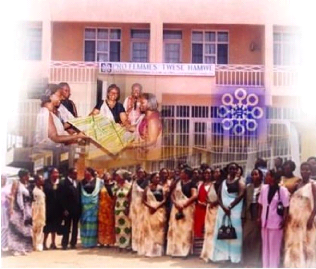
8
1.10 HISTORICAL BACKGROUND OF PRO- FEMMES /TWESE HAMWE
ORGANISATIONS UMBRELLA
In 1991, there were associations working for women promotion.
They had been initiated for various specific reasons.
In 1992, 13 Rwandan Associations decided to combine their
efforts and created the umbrella PRO-FEMMES/TWESE HAMWE. On 18th
October 1992 it was publicly started and obtained its legal status in 2002.
(Inside Pro-Femmes newsletter Issue no 1)
1.11 PRO -FEMMES / TWESE HAMWE'S VISION
PRO-FEMMES/TWESE HAMWE is longing for a Rwandese society rid
of all forms of gender related discrimination, and thus characterised by
equality and equity between men and women in the development process and in a
context of a stable and peaceful society.
It has made a recognizable impact at national, regional and
international levels. Through cooperation, coordination and consultative
meeting between member organizations, the government, parliament and
international organization.
9
Pro-Femmes/Twese Hamwe advocated and contributed towards
revision of discriminatory laws and initiation of new ones in favour of women
and children, ratification of different conventions on human and women rights
like CEDAW, UNSCR1325, Beijing Platform for action, mobilization of women to
participate in decision making decision positions by training women candidates
through Women can do it program among others.
Pro-Femmes/ Twese Hamwe endeavours to promote gender equality
through advocacy, economic empowerment, and equal participation of women and
men in the development process and fight gender based violence for a better
Rwandan society. (Pro-Femmes report 2011).
1.12 PRO- FEMMES / TWESE HAMWE'S MISSION Its
mission is to contribute to:
> the eradication of all forms of discrimination towards
women and promotion of their socioeconomic, political and legal status,
> the enhancement of the institutional capacity of the
umbrella and member associations , and the promotion of:
· A sustainable human development based on gender and
· A culture of peace based on social justice, respect of
human rights, tolerance and nonviolence.
1.13 PRO -FEMMES/TWESE HAMWE'S OBJECTIVES
· To combine efforts, work for change so as to eradicate
all forms of discrimination and violence towards women;
· To be a consultation and a reflection framework on
success strategies on mission of member associations committed to the promotion
of peace, women's social, economic, cultural and legal status;
· To facilitate exchanges between various member
organisations and to promote partnership with organisations or institutions
working for women promotion.
10
1.14 CONCERN OF DUTERIMBERE MFI
The Duterimbere MFI is microfinance institution which
receives the economies of usual customers served by the banking system and
those who don't have sufficient guaranties to offer in order to ensure the
refunding of the authorized credit. The activities of saving and credit for
Duterimbere MFI were created on June 5th, 1997.
Last year, Duterimbere made a net profit of Rwf116 million
and is targeting a total of Rwf200 million as proceeds this year, which signals
the recovery of MFIs after a period of poor business practices and now that
institution have a total of 53,500 customers, the women have 70% of clients.
1.14.1Duterimbere objectives
? To aim at the improvement of economic and social conditions
of its members, in particularly the women
? To provide the financial services (Saving and credit) to
the population with low and to the women in particularly
? To help the women to carry out the income activities via
individual projects and the groups of solidarity
? To promote the agriculture of saving and economic, social
education and cooperatives of its members.
The customers situation of Duterimbere MFI period of 2009 to
2011 according of the different sites/branches
Sites
|
2009
|
2010
|
2011
|
|
Male
|
Female
|
Male
|
Female
|
Male
|
Huye
|
982
|
327
|
2,454
|
818
|
2,643
|
880
|
Nyanza
|
374
|
124
|
438
|
146
|
1583
|
527
|
Ruhango
|
3,286
|
1,095
|
4,620
|
1,539
|
7,101
|
2,367
|
Muhanga
|
7,674
|
2,558
|
8,032
|
2,677
|
10,963
|
3,652
|
Musanze
|
2,679
|
893
|
3,399
|
1,133
|
4,010
|
1,336
|
Nyagatare
|
954
|
317
|
2316
|
771
|
2,859
|
952
|
|
11
Mutimba
|
453
|
151
|
1,321
|
440
|
1,470
|
490
|
Rukomo
|
815
|
271
|
1,147
|
382
|
1,641
|
547
|
Gatsibo
|
630
|
209
|
1,312
|
437
|
1,541
|
513
|
Gahini
|
744
|
247
|
889
|
296
|
1089
|
363
|
Kayonza
|
662
|
220
|
891
|
296
|
1,268
|
422
|
Kigali
|
444
|
147
|
1389
|
462
|
2,288
|
762
|
Total
|
19,692
|
6,564
|
28,204
|
9,401
|
38,451
|
12,816
|
|
Source: Duterimbere MFI report
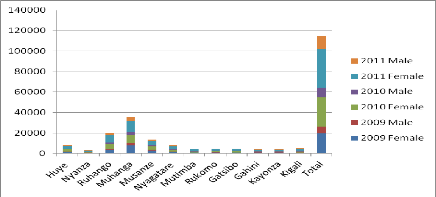
Situation of loans of Duterimbere MFI given its
customers from 2009 to 2011
Sites
|
Total (Rwf million and billions)
|
2009 (credit in Rwf
million and billions)
|
Total (Rwf million and billions)
|
2010 (credit in Rwf
million and
billions)
|
Total(Rw
f million
and
billions)
|
2011(credit in Rwf million and billions)
|
|
|
Female
|
Male
|
|
Female
|
Male
|
|
Female
|
Male
|
Huye
|
76,236
|
53,365
|
22,871,072
|
69,536
|
48,675
|
20,861
|
131,046
|
91,732
|
39,313
|
Nyanza
|
48,733
|
34,113
|
14,619,992
|
30,278
|
21,194
|
9,083
|
61,041
|
42,729
|
18,312
|
Ruhango
|
318,858
|
223,200
|
95,657,547
|
423,508
|
296,456
|
127,052
|
477,462
|
334,223
|
143,238
|
Muhanga
|
394,274
|
275,992
|
118,282,30 9
|
442,260
|
309,582
|
132,678
|
496,947
|
347,863
|
149,084
|
Musanze
|
150,193
|
105,135
|
45,057,947
|
244,041
|
170,828
|
73,212
|
383,066
|
268,146
|
114,919
|
Nyagatar e
|
108,984
|
76,289
|
32,695,420
|
192,481
|
134,737
|
57,744
|
277,966
|
194,576
|
83,390
|
Mutimba
|
75,063
|
52,544
|
22,519,049
|
124,192
|
86,934
|
37,257
|
149,036
|
104,325
|
44,710
|
|
12
Rukomo
101,696
|
71,187
|
30,508,985
|
142,401
|
99,681
|
42,720
|
163,758
|
114,630
|
49,127
|
Gatsibo
|
|
41,579
|
17,819,715
|
165,325
|
|
|
|
150,698
|
64,584
|
|
59,399
|
|
|
|
115,728
|
49,597
|
215,283
|
|
|
Gahini
|
|
42,920
|
18,394,614
|
75,385
|
|
|
|
64,147
|
27,491
|
|
61,315
|
|
|
|
52,769
|
22,615
|
91,638
|
|
|
Kayonza
|
|
20,096
|
8,612,619
|
65,181
|
|
|
|
84,775
|
36,332
|
|
28,708
|
|
|
|
45,626
|
19,554
|
121,108
|
|
|
Kigali
|
|
44,594
|
19,111,899
|
140,174
|
|
|
|
157,900
|
67,671
|
|
63,706
|
|
|
|
98,121
|
42,052
|
225,571
|
|
|
Total
|
|
1,041,01
|
446,151
|
2,114,76
|
|
|
|
1,955,74
|
838,178
|
|
|
9
|
|
7
|
1,480,33
|
634,430
|
2,793,928
|
9
|
|
|
1,487,170
|
|
|
|
7
|
|
|
|
|
|
Source: Duterimbere MFI report
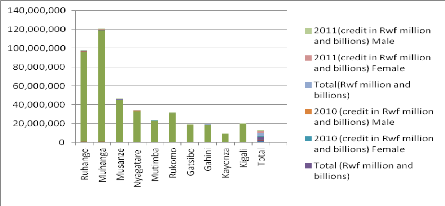
13
CHAPTER TWO: REVIEW OF LITERATURE
2.1. INTRODUCTION
The literature review on how microcredit impact women
empowerment will allow to assess and let women survive live a life with
dignity, humanity, respect, self esteem and self reliance. The emphasis will
assess the ability to exercise choice incorporates three interrelated
dimensions and the women will be empowered when they will have full control
over their own life.
According to KreditanstaltfürWiederaufbau (KfW)
microfinance is a significant instrument for poverty reduction, whether it can
also be seen as a tool for women's empowerment is of special interest to
KfW.
In order to answer the question many studies (reports,
journals, microfinance profile) have been carried out in developing countries
and the majority of these studies have been carried on Rwandan women because
this was the country where microfinance schemes first time started by women
umbrella called Pro-Femmes/ Twese Hamwe through its member called Duterimbere
microfinance institution since 1992.
The main objective of this initiative was to provide loans to
poor people without collateral, alleviating poverty and unleashing human
creativity and endeavor of the poor people.
Microfinance has proven its potential to generate results and
in general, studies suggested the poorest seldom benefit from
microfinance, while the middle and upper poor benefit the most. Women
in particular face significant barriers to achieving sustained increases in
income and improving their status, and require complementary support in other
areas, such as training, marketing, literacy, social mobilization, and other
financial services (e.g.,
Consumption loans, savings).
In fact, it is difficult to separate the impact of
microfinance from that of other interventions (Maclsaac, 1997).Further Maclsaac
(1997) said that «most women borrowers have only partial control over
loans, or have relinquished all control to male members of the family. This has
serious implications for the impact of gender equity. However, this is not to
say benefits are non-
14
existent. As part of a broader effort to raise awareness and
mobilize women, credit could play an important role as an «entry
point» to strengthen women's networks and mobility, increase their
knowledge and self-confidence, and increase their status in the
family.»
In the context of Rwandan women and men discusses that
«during the last two decades, micro-credit approach has been increasingly
incorporated in the development discourse. Specially the loan is given to the
women and the popular belief is that women are benefited and empowered and are
being acknowledged for having a productive and active role and thus it is the
gateway of gaining freedom for themselves.»
There are few studies in the context of Pakistan which
discussed the relationship between microcredit and microfinance and women
empowerment, one of them was a review based study done by Malik and Luqman
(2005).
Thus I see a broadening of the concept of microfinance the
current challenges is to find efficient and reliable ways of providing a richer
menu of microfinance products.
Microfinance and other services for poor people are important
instruments for poverty reduction and for entrepreneurship development
especially for women according to a report prepared by the United Nations
Secretary General Kofi Annan (Ref. world submit and social development and
microfinance 6-12 March 1995 Copenhagen).
They assert that «from the previous research studies, it
was concluded that micro finance or microcredit programs had the potential and
powerful impact on women's empowerment. Although these were not always
empowering all women, most women did experience some degree of empowerment
because it was a complex process of change experienced by all individuals
somewhat differently and varied from culture to culture.
Microfinance programs had both positive and negative impacts
on women's empowerment and eradication of poverty throughout the world.»
There are different perspectives on the issue of microfinance in connection
with women empowerment. In few cases, women were unable to use the microcredit
to empower themselves. In this regard, Goetz and Gupta (1996) said that
«most programs could not ensure that women retained control over the
money. The Women commonly hand over control of the loan or invest it in a
family enterprise.
15
2.2 DEFINITION OF MICROFINANCE CONCEPTS
It is necessary first to make explicit definitions and
assumptions which much of this paper work is based. These points are based on
mostly on field experience with microfinance program and in particular the work
of MFIs in developing countries rather than in the middle income and industries
countries.
1. What is microfinance?
The term refers to the provision of financial services to
low-income clients; including the self-employed. Financial services generally
include savings and credit. However, some microfinance organizations also
provide insurance and payment services. (UNIFEM, 2001)
In addition to financial intermediation, many MFIs also
provide social intermediation services such as group formation, development of
self confidence, and training in financial literacy and management capabilities
among members of a group. Thus the definition of microfinance often includes
both financial intermediation and social intermediation. Microfinance is not
simply banking, it is a development tool.
Microfinance activities usually involve:
+ Small loans, typically for working capital.
+ Informal appraisal of borrowers and investments.
+ Collateral substitutes, such as group guarantees or compulsory
savings.
+ Access to repeat and larger loans, based on repayment
performance.
+ Streamlined loan disbursement and monitoring.
+ Secure savings products.
MFIs can be nongovernmental organizations (NGOs), savings and
loan cooperatives, credit unions, government banks, commercial banks, or
nonbank financial institutions.
The people who require the micro finance are typically
self-employed, low-income entrepreneurs in both urban and rural areas. Clients
are often traders, street vendors, small farmers, service providers
(hairdressers, rickshaw drivers), and artisans and small producers, such as
blacksmiths and seamstresses. Usually their activities provide them stable
source of income (often from more
16
than one activity). Although they are poor, they are generally
not considered to be the "poorest of the poor."(Lidgerwood, 1999)
2. What is economic empowerment?
According to Cheston & Kuhn, (2002); «the economic
empowerment is bringing people on the outside of a decision process into
it» (Rowlands, 1997). It is the ability to obtain an income that enables
participation in economic decision making. Individual become empowered when
they obtain, the right to determine choices in life and to influence the
direction of change, through the ability to gain control over material and non
material resources (Rowlands, 1997).
Batliwala (1994) also sees economic empowerment as a process
of challenging existing power relations and of gaining greater control over the
sources of power or is social force meant to inspire the poor to challenge the
status quo.
According the UNIFEM, economic empowerment is gaining the
ability to generate choices and exercise bargaining power, developing a sense
of self worth, a belief in one's ability to secure desired changes, and the
right to control one's life. Empowerment is about change, choice, and power. It
is a process of change by which individuals or groups with little or no power
and ability to make choices that affect their lives.
Microfinance programs can have tremendous impact on the
empowerment process if their products and services take these structures into
account. In the order for women to be empowered, she needs access to the
material, human, and social resources necessary to make strategic choices in
her life. Not only have women been historically disadvantaged in access to
material resources like credit, property, and money, but they have also been
excluded from social resources like education or knowledge of some
businesses.
Access to resources alone does not automatically translate
into empowerment or equality; however, women must also have the ability to use
the resources to meet their goals. In order for resources to empower women,
they must be too able to use them for a purpose that they choose. Naila Kabeer
uses the term agency to describe the processes of decision making, negotiation,
and manipulation required for women to use resources effectively. Women who
have been excluded from decision making for most of their lives often lack this
since of agency that allows them to
define goals and act affectively to achieve them. Since women's
economic empowerment is the key to socio economic development of the community,
bringing women into the mainstream of national development has been a major
concern of government of Rwanda.
Figure 1: Framework of women's empowerment through
microfinance (Household model)
Women economic

Change in intra-household
Empowerment

increased status of

Bargaining and gender
relation women within household
Income under women's Control increases
17
Women decision Increased independent increased household

Women's access to credit
About savings and income income
Credit use

Source: The role of microfinance in economic empowerment of
women in Rwanda, 2009
It has been well documented that an increase in women's
resources results in the well being of the family, especially children (Mayoux,
1997; Kabeer, 2001; Hulme and Mosley, 1997). A more feminist point of view
stresses that an increased access to financial services represent an
18
opportunity for greater economic empowerment. Such as
organizations explicitly perceive microfinance as a tool in the fight for the
women's rights and independence. Finally, keeping to up with the objective of
financial viability, an increasing number of microfinance institutions prefer
women members as they believe that they are better and more reliable
borrowers.
Hashemi
et.al (1996), investigated whether women's
access to credit has any impact on their lives, irrespective of who had the
managerial control. Their results suggest that women's access to credit
contributes significantly to magnitude of the economic contributions reported
by women, to the likelihood of an increase in asset holdings in their own
names, to an increase in their exercise of purchasing power, and in their
political and legal awareness as well as in combined economic empowerment
index. Also Kabeer (1999), stresses that women's economic empowerment is about
the process by which those who have been denied the ability to make strategic
life choices acquire such ability. According to her, it is important to
understand economic empowerment as a process and not an instrumentalist for of
advocacy.
3. Various Credit Lending Models
Microfinance institutions are one of the oldest financial
institutions in the world, but like all the other institutions in the world,
with time they have adapted various kinds of changes, and have started using
various credit lending models. The Microfinance service/or community has
divided itself into hierarchies. Some of the popular microfinance credit
lending models adopted across the world are:
Associations: In this type of model, a
target community forges together to form an association through which a variety
of microfinance activities are carried out. The microfinance activities may
also include savings. The associations may comprise of youth, women, or be
formed around cultural, religious, or political issues.
In some of the countries a legal body can also form an
association. These legal associations have certain advantages, like collection
of insurance, fees, tax breaks, and provide other protective measures.
Community banking: This financing model
considers the whole community as one unit and facilitates the establishment of
semi-formal and formal institutes through which microfinance are administered.
Usually NGOs and other similar organizations take it upon themselves to form
such institutions, and also educate the community members in diverse financial
activities.
Co-operatives: A co-operative is an
independent association of people who come together voluntarily to meet their
mutual economic, social and cultural aspirations and needs through a
19
egalitarian controlled enterprise. Sometimes the cooperatives
also include savings activities and member financing as well.
Credit Unions: A credit union is a
member-driven unique self-help financial institute comprising of members of a
specific group like labor unions or a social fraternity who assent to save
money and make loans to each other out of that fund at reasonable interest
rates. A credit union membership is free to all, and it follows a democratic
approach in electing the director as well as the committee representatives.
Grameen model or JLG model: The Grameen
model is the most popular model which is practiced by so many MFIs all around
the world. The grameen model entails that a bank unit be composed with a field
manager and a set of bank staff covering a specified area, like 15 to 20
villages. The banking service starts when the manager and the staff familiarize
themselves with the native people and explain to them the intent, functions
motives, and mode of operation. Finally, groups comprising of five future
borrowers are formed, out of which only two people get the loan initially, and
if within fifty weeks they return the principal amount along with interest, as
per the banking rules, the othermembers become eligible as well for taking
loans. This is done, so that there is a collective liability on the group,
which serves as guarantee against the loan as risk factor is so high.
Group: This model is based on overcoming
individual shortcomings by the aggregated accountability and security
engendered by the formation of a group of these individuals. This collective
approach also helps in educating and building awareness, collective negotiation
powers, peer pressure etc.
Individual: This is the simplest and the
oldest credit lending model where small loans are given straight to the
borrower. In most cases such loans are accompanied by socio-economic services
like education and skill development.
Intermediaries: As the name suggests this
model is a `go-between' organization operating between the lender and borrower.
They play a critical role of creating credit cognizance like starting savings
programs and thus raising the credibility of the borrowers to a sufficient
level. These intermediaries can be NGOs, individuals, commercial banks etc.
Non-Governmental Organizations: NGOs are
very active in the field of micro-credit, be it creating consciousness of the
importance of micro-credit, or developing tools and resources to monitor and
identify righteous practices. The NGOs have also created many opportunities to
help people learn all about micro-credit practices and principles through
organizing workshops, seminars, training programs etc..
20
Rotating Savings and Credit Associations: A
group of people join together and make periodic cyclical contributions to a
common fund that is given to a member in a lump sum. After receiving the amount
the member starts paying back by making regular contributions.
Small Business Enterprises (SME): They get
loans from micro-credit programs for creating employment, increasing income
etc. The micro credit is either provided directly to the SME or as a part of a
bigger SME development program.
Village Banking: This is a community based
banking. In this 15-50 low income individuals who seek self-employment come
together to collect funds and give loans. The initial capital is generally
arrived from outside, but the members follow a democratic approach in operation
and moral collateral for repayment. (
http://www.gdrc.org)
Literature prepared for the Microfinance Summit in Washington
in February 1997, many donor statements on credit and NGO funding proposals
presented an extremely attractive vision of increasing numbers of expanding,
financially self-sustainable micro-finance programs reaching large numbers of
women borrowers. Through their contribution to women's ability to earn an
income these programs are assumed to initiate a series of `virtuous spirals' of
economic empowerment, increased well-being for women and their families and
wider social and political empowerment. Female-targeted programs have
supplanted support for many other gender strategies in many donor agencies.
However parallel to, but to a large extent marginalized by,
the enthusiasm of donors and many MFIs and NGOs some researchers have
questioned the degree to which micro-finance services in themselves benefit
women. Some argue strongly that current models of microfinance where the
overriding concern is financial sustainability divert resources from other more
effective strategies for empowerment and/or poverty alleviation. There are now
beginning signs of a change in thinking. On the one hand donors are beginning
to be more skeptical of the achievements and potential of microfinance on its
own and also more interested in self-managed programs. On the other hand there
is rapid innovation at program level and an increasing focus on participation.
These trends are combined with a growing recognition of the need to address
macro-level constraints. The solutions proposed have been varied and are far
from presenting a coherent strategy for poverty elimination and empowerment.
Nevertheless there are now spaces for introducing policy changes which may
increase the contribution of microfinance to both these development aims.
21
2.3 MICROFINANCE INSTITUTION
A micro finance institution is an organization that offers
financial services to the poor. Most MFIs are non-governmental organizations
committed to assisting some sector of low income earning population. Almost all
of these MFIs offer micro credit and only take back small amounts of savings
from their borrowers, not from the general public.
Within the microfinance industry the term microfinance
institution has come to refer to a wide range of organizations dedicated to
providing these services NGOs, Credit Unions, Cooperatives, Private commercial
banks and non bank financial institutions some that have transformed from NGOs
into regulated institutions and parts of state owned banks. (Rwanda
microfinance forum report, 2000)
2.4 CHALLENGES FACED BY MICRIFINANCE INSTITUTIONS
Among challenges facing microfinance industry in developing
nations are:
? High cost of service delivery with poor infrastructure,
regulatory policy issues and the need to develop institutional leadership.
Because infrastructure and communication technology remain largely
underdeveloped in most developing nations, it is significantly more expensive
for microfinance institutions in these nations to operate compared to their
peers in developed countries.
? Another challenge is policy making and government
regulations, which vary by country. I many countries, the supervisory capacity
of central banks, which holds the ultimate responsibility of financial sector
needs an adjustment. The countries which are able to close the microfinance
demand gap most successfully will be those that improve their policy frameworks
and adapt their legal and regulatory systems in line with rapidly changing
environment.
? A low population density area where the number of women to
form a variable group is inadequate also poses as challenges. The situation is
worsened by the unequal distribution of the family resources, which makes it
difficult for women to raise the necessary savings and participate in a
group.
? Some women access credit, but only to pass it into others
who are not directly accountable, leaving them with the loan repayment burden.
The one year repayment period is one of the reasons for default in repayments.
Examples of such failure make other women reluctant to borrow. Another one is
because of the society's perception of a
22
women's place in the home, some women are reluctantly not
informed of the existence of sources of finance.
2.5 MICROFINANCE AND WOMEN'S EMPOWERMENT: QUESTIONNING
`VIRTUOUS SPIRALS'
Micro-finance programs have a significant potential
contribution to women's economic, social and political empowerment. Access to
savings and credit can initiate or strengthen a series of interlinked and
mutually reinforcing ' virtuous spirals ' of empowerment (See Figure 2).
· Women can use savings and credit for economic
activity, thus increasing incomes and assets and control over these incomes and
assets.
· This economic contribution may increase their role in
economic decision-making in the household leading to greater well-being for
women, children as well as men.
· Their increased economic role may lead to change in
gender roles and increased status within households and communities.
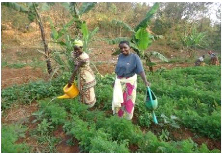
The women in agriculture sector
These virtuous spirals are potentially mutually reinforcing in
that both improved well-being and change in women's position may further
increase their ability to increase incomes and so on.
This process of empowerment may be further reinforced by group
formation focusing on savings and credit delivery:
· Women can access wider information and support networks
for economic activity.
· Groups can support women in disputes within the household
and community
· Groups can link to wider movements for change in women's
position.
23
Particularly in Rwanda microfinance programs like those of PTH
through of Duterimbere, Inkingi, Agaseke, Goshen, etc have been pioneers of an
empowerment approach to development for women in the informal sector and rural
areas.
However although it is clear that microfinance programs have
led to such changes for some women in microfinance programs, these changes are
not an automatic consequence of savings and credit alone or of group formation.
Evidence suggests that even in financially successful micro finance
programs:
· Most women remain confined to a narrow range of ' female
' low-income activities
· Many women have limited control over income and/or
what little income they earn may substitute for former male household
contributions as men retain more of their earnings for their own use
· Women often have greater workloads combining both
production and reproductive tasks
· Women's expenditure decisions may continue to
prioritize men and male children while daughters or daughters in law bear the
brunt of unpaid domestic work
· Where women actively press for change this may
increase tensions in the household and domestic violence
· Women remain marginalized in local and national level
political processes
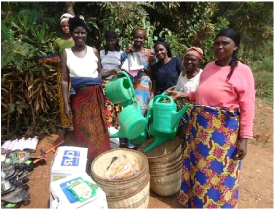
Together association of women supported by Dutermbere
Microfinance through microcredit.
24
This is not just a question of lack of impact, but may also be a
process of disempowerment:
? Credit is also debt. Savings and loan interest or insurance
payments divert resources which might otherwise go for necessary consumption or
investment.
? Putting the responsibility for savings and credit on women
may absolve men of responsibility for the household.
? Where group meetings focus only on savings and credit this
uses up women's precious
work and leisure time, cutting program costs but not necessarily
benefiting women.
Impacts are therefore very complex. There may be trade-offs
for individual women which they negotiate to the best of their ability. There
may be both reinforcing and conflicting changes at household level. Impacts on
gender inequalities at the community level may also combine elements of
empowerment and disempowerment and affect different women in different ways.
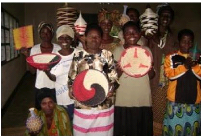
Handcraft trading for AGASEKE Association, there are used the
loans microfinance in their activities.
Importantly women themselves are not passive victims, but
active participants using opportunities as best they can in the context of the
many constraints of gender inequality and poverty. Many apparent positive
impacts may be more due to the determination and ingenuity of women than to
program policy. Many negative impacts may be unavoidable because of the
magnitude of constraints.
25
26
Fig.1 VIRTUOUS SPIRALS :
QUESTIONING ASSUMPTIONS
SAVINGS
AND
CREDIT
?MEN MAY TAKE LOAN
WOMEN'S
DECISION ABOUT
SAVINGS AND
CREDIT USE
REPAYMENT
INCREASED WELLBEING
?DIVERSION OF LOAN
?WOMEN MAY GIVE TO MEN
?MEN MAY WITHDRAW THEIR
INCOME CONTRIBUTION
WOMEN'S
DECISIONS ABOUT
CONSUMPTION
?WOMEN'S DECISIONS MAY
REPLICATE
GENDER INEQUALITY
WOMEN'S
MICRO-
ENTERPRISE
?INCOMES MAY BE LOW
INCREASED
INCOME
SOCIAL AND POLITICAL
EMPOWERMENT
ABILITY TO
NEGOTIATE CHANGE
IN GENDER
RELATIONS
?MAY REINFORCE
EXISTING ROLES
?MAY HAVE
LITTLE
IMPACT
?MEN MAY CONTROL INCOME
INCOME UNDER
WOMEN'S
CONTROL
?WOMEN MAY USE
UNPAID FAMILY
LABOUR
IMPROVED
WELLBEING OF
WOMEN
INCREASED
STATUS AND
CHANGING ROLES
IMPROVED
WELLBEING OF
CHILDREN
|
|
WOMEN'S
NETWORKS AND
MOBILITY
|
?WOMEN MAY
NOT WORK FOR
WIDER CHANGE
|
|
|
|
|
|
ECONOMIC EMPOWERMENT
IMPROVED
WELLBEING OF
MEN
|
INCREASED
WAGE
EMPLOYMENT
FOR WOMEN
|
WIDER MOVEMENTS
FOR
SOCIAL
AND POLITICAL
CHANGE
|
Source: UNFEM PAPER, 1995
|
|
|
|
27
2.6 Theoretical links between Microfinance and Poverty
2.6.1Reduction/Analytical Framework
This section is a presentation of theoretical debates about
microfinance and poverty reduction and an illustrative analytical framework
that is relevant for understanding this study.
2.6.2 Poverty Reduction and Microfinance
The poor and poverty reduction has become the object of
unparalleled concentration now days both at national and international levels (
www.countercurrents.org).
As one of the MDGs, elimination of poverty has become a key issue for all those
interested in development of the developing countries (Nalunkuuma, 2006), with
microfinance as one of the predominant methodologies for making finance
accessible to the poor especially among the donor community. Many donor
agencies and governments in developingcountries are now funding a growing
number of microfinance organizations (Lont and Hospes 2004).
Microfinance is considered to be a solution for overcoming
poverty. Lack of savings and capital make it difficult for many poor people who
want jobs in the farm and non-farm sectors to become self employed and to
undertake productive employment-generating activities. Providing credit seems
to be away to generate self employment opportunities for the poor. But because
the poor lack physical collateral, they have almost no access to institutional
credit.
At the same time, informal lenders in many developing
countries often charge high interest rates, inhibiting poor households from
investing in productive income-increasing activities (Khandker, 1998).
According to Guerin and Palier (2005), the primary objective
of microfinance is the provision of financial aid on a small scale to those who
are on the fringes of society, too overwhelmed by the formal restrictions and
procedures of the organized sector, too vulnerable to help them and left out of
the mainstream. Microfinance provided to the vulnerable has to be synonymous
with empowerment of the beneficiary groups in order to sustain their income
flow and make them economically independent (ibid)
Microfinance institutions are therefore intended to provide
reliable and affordable financial services to the poor by providing cheap
credit with minimum requirements for example they demand for securities which
are affordable by the poor clients. These schemes also cut on the
28
bureaucratic tendencies which make it easier for the poor
people to access micro credit. It is argued these microfinance institutions
(MFIs) are in position to enhance the ability of the poor to move out of
poverty as well as to prevent those above the poverty line from sliding into
poverty (Qorini Iwan, 2005).
Montgomery and Weiss point out that the case for microfinance
as a mechanism for poverty reduction is simple. If access to credit is
improved, it is argued, the poor can finance productive activities that will
allow income growth, provided there are no other binding constraints
(Montgomery and Weiss, 2005).This is a route out of poverty for the
non-destitute chronic poor. For the transitory poor who are vulnerable to
fluctuations in income that bring them close to or below the poverty line,
microfinance provides the possibility of credit at times of need and in some
schemes the opportunity of regular savings by a household itself that can be
drawn on. The avoidance of sharp declines in family expenditures by drawing on
such credit or savings allows `consumption smoothing' (ibid).
However, there are inconclusive arguments on the impact and
the role of microfinance and micro credit programs in poverty reduction.
Proponents of microfinance consider that poor's access to credit boosts income
levels, increases employment at the household level and thereby alleviates
poverty.
Also that, credit enables poor people to overcome their
liquidity constraints and undertake some investments. Furthermore that credit
helps poor people to smooth out their consumption patterns during the lean
periods of the year(Okurut et al 2004).By so doing, credit maintains the
productive capacity of the poor households (ibid).
Zeller and Sharma (1998) cited by Okurut et al (2004) argued
that microfinance can help to establish or expand family enterprises,
potentially making the difference between grinding poverty and economically
secure life.
But Burger (1989) observed that microfinance tends to
stabilize rather than increase income, and tends to preserve rather than create
jobs. In the same view, Arbuckle et al (2001) cited by Nalunkuuma (2006)
indicates that studies carried found little to recommend that micro credit has
any significant impact on enterprise incomes. Evidence by Coleman (1999)
suggested that the village bank credit did not have any significant impact on
physical asset accumulation; production and expenditure on education. The women
ended up in a vicious cycle of debt as they used the money from the village
bank for consumption and were forced to borrow from money
29
lenders at high interest rates to repay the village bank loans
so as to qualify for more loans. However, impact for women who had access to
bigger cheaper loans from the village bank was significant. The main conclusion
of the study was that credit is not an effective tool for helping the poor to
enhance their economic condition and that the poor are poor because of other
factors (like lack of access to markets, price shocks, un equitable land
distribution) but not lack of credit. A study of 13 MFIs in seven developing
countries concluded that households' income tended to increase at a decreasing
rate, as the debtors income and asset position improved (Mosley and Hulme 1998)
cited by Okurutet al (2004).Similarly, Hulme and Mosley (1996) cited by Lont
and Hospes(2004) in a study made on Twelve lending institutions providing
micro-lending services in seven countries found that the impacts of microcredit
on the poor were on average small or negative relative to the control group.
Results by Diane and Zeller (2001) in the study done in Malawi also suggested
that microfinance did not have significant effect on household income. Fisher
and Sriram (2002) stress that access to microfinance services protects the poor
against the often severe consequences of fluctuating incomes, ill health, death
and other emergency expenditures. Despite the overwhelming claims that
microfinance credit works best for the poor people, Johnson and Rogaly (1997)
argue that poorest borrowers become worse off as a result of credit and that it
makes them vulnerable and expose them to high risks.
Using gender empowerment as an impact indicator, some studies
argue that microcredit has a negative impact on women empowerment (Goetz and
Gupta, 1994). Goetz and Gupta (1994) as cited by Kabeer (2000) using a five
point index of `managerial control» over loans as their indicator of
empowerment. At one end of their index are women who are described as having
`no control' over their loans: these are women who either had no knowledge of
how their loans were used or else had not provided any labor into the
activities funded by the loan. At the other end are those who were considered
to have exercised `full' control, having participated in all stages of the
activity funded by the loan including the marketing of the produce. The study
found that the majority of women, particularly married women exercised little
or no control over their loans by this criterion. Sebstad and Chen (1996) as
cited by Lont and Hospes (2004) in their summaries of the thirty-two research
and evaluation reports found that micro lending to women had positive impacts
on their empowerment in Asian countries. However, reports from African programs
found very little or no impacts of microcredit on the empowerment of women. In
the same studies, credit had a positive impact on households' income, but the
impacts on health, on
30
the nutrition level of family members, and on children's
attendance at schools were not conclusive.
Also the view that it is the less badly-off poor who benefit
principally from microfinance has become highly influential and for example was
repeated in the World Development Report on poverty (World Bank, 2000) cited by
Montgomery and Weiss ( 2005). Simanowitz and Alice (2002) put it clearly that,
the microfinance industry has concentrated not on reaching the poor but rather
on financial and situational performance. Meanwhile Mayoux (2001) argues that
microfinance institutions are undergoing a period of rapid innovations. They
are coming up with products and new methodologies for reaching the broader
category of poor people including the poorest of the poor. This will enable
microfinance to have a significant impact in achieving poverty reduction.
Also where group lending is used, the very poor are said to be
excluded by other members of the group, because they are seen as bad credit
risk, jeopardizing the position of the group as a whole. Similarly, it's argued
that when professional staff operates as loan officers, they may exclude the
very poor from borrowing, again on the grounds of the repayment risk
(Montgomery and Weiss, 2005). Simanowitz in regard to groups points out that
while the use of the groups has the potential to build social capital, develop
skills; the way they are used varies considerably between MFIs. Some use them
solely as means for creating peer group pressure while others use them more
deliberately as vehicles of the empowerment (Simanowitz, 2003). From the above
discussions, we realize that core issues remain how to make microfinance
accessible to the poor and ensure that the benefits are positive. For the
purpose of this study, the above theoretical debates form the bedrock to
explore into the role of microfinance in poverty reduction in Rwanda.
2.6.3 Analytical Framework
There are various factors and constraints which may explain
why people are poor: inadequate amount and/ or quality of assets; constrained
opportunities for welfare generation from assets; and qualitative factors such
as vulnerability, powerlessness and social exclusion (Gulli and Berger 1999).
The main contribution of financial services savings, credit and insurance is to
address their financial constraints and to facilitate management of money
(ibid)
FIGURE 3: LINKING MICROFINANCE WITH POVERTY
REDUCTION

31
MFI OUTREACH IMPACT DOMAINS POVERTY REDUCTION
? MFI
· Mission and objectives
· Methodology, terms and conditions ?
OUTREACH
· Scale
· Depth
· Breadth
· Geographical
· Quality
? IMPACT DOMAINS
· Income increases
· Protection against income shocks + reduced
vulnerabilities +diversified IGAs
· Health and nutrition improvement
· Children Education
· Empowerment and building social capital
? Poverty Reduction
Source: Adapted from Gulli and Berger (1999)
This analytical framework is build on the ground that if the
MFI mission and objectives are geared towards poverty reduction, then the
terms, conditions and methodology and product design have to be favorable for
the poor to access the microfinance products and services which will be
reflected in the outreach; how many poor people are reached (scale of
outreach), how poor are the clients (depth of outreach), in which economic
sectors are they engaged (breadth of outreach), where do they live
(geographical outreach) and the quality which is how the services fit the needs
of potential clients. Depending on whether the poor have been reached with
32
microfinance, then impact may be expected in terms of (i)
income generation, (ii) asset building and reduced vulnerabilities defined as
increases in ownership of household's physical assets and reduced
vulnerabilities as the poor are encouraged to save and diversify their
livelihood activities, (iii) empowerment which means enabling the poor to have
greater control over the resources and their lives and taking part in family
and community decisions,(iv) building social capital implying reduced
isolation, opportunity to share information and building the bond that was not
previously there. (V) Good health in terms of improvement in nutrition and
afford medical care, and (VI) education of clients' children which is investing
in children's education as a result of new income from micro-enterprise. This
will in turn lead to poverty reduction on women and all family members.
33
CHAPTER THREE: RESEARCH METHODOLOGY
3.1. RESEARCH METHODOLOGY
This research methodology was designed in a simple way and
conducted using a detailed questionnaire and structured interviewed to gather
and systematically track the client's responses on the impact of microfinance
towards their economic empowerment.
Research methodology can be described as a course of action
which describes the tools that are used when conducting a research study. This
chapter involves various methods, techniques and procedures of the data
collection, processing as well as data analysis that were used to collect,
analyze, and interpret data which gives an overview of how the entire study was
conducted to reach a final conclusion on how microfinance leads to women's
economic empowerment. I t also discusses the case study, the population, sample
size, and sampling the techniques used during research study such as,
documentations, questionnaires and interviews. The chapter cannot conclude
without taking about various procedures for data processing and analysis. These
procedures include percentages, editing, coding, and tabulation.
3.2 CASE STUDY
Pro-Femmes/ Twese Hamwe through Duterimbere Microfinance
Institution is the oldest and one of the renowned Microfinance institutions in
Rwanda. The research chose this organization because of its outstanding
performance in promoting economic development of poor in Rwanda especially the
marginalized women. To this point it serves as an important source of content
for the researcher to achieve the objective of her research topic. The bank
helps the unemployed women to get microcredit loans to invest in small income
generating activities to ensure them with income self sustenance result into
economic empowerment of Rwanda women.
3.3. AREA OF THE STUDY
An area of the study refers to the area in which the research
was conducted. The research was carried out the PTH through Duterimbere
Microfinance Institution in Kigali city. The reason for choosing to study the
clients of PTH through Duterimbere Microfinance Institution is because the
majorities are women who are most vulnerable and marginalized in Rwandan
society. Secondly Pro-Femmes/ Twese Hamwe through Duterimbere Microfinance
Institution is one of pioneers' of women microfinance in Rwanda. According to
Pro-Femmes/ Twese Hamwe
34
through Duterimbere Microfinance Institution, its mission is
to provide unique financial services to low income groups in Rwanda and these
are mainly women.
Both employees and clients of Duterimbere microfinance
institution were considered. The Duterimbere microfinance institution has many
clients located in almost all districts of Rwanda, but due to limited time the
researcher targeted clients in both Nyarugenge, Kicukiro and Gasabo districts
of the Kigali City in mid of May 2012. In addition these districts were
selected purposely because of the density of the credit beneficiaries in the
area. There are many microfinance institutions that provide similar
microfinance services, their coverage in this research would therefore require
enough time and fund to meet necessary requirement.
3.4. POPULATION OF THE STUDY
The target populations were all beneficiaries of Pro-Femmes/
Twese Hamwe through Duterimbere Microfinance Institution in Kigali city
specifically in Nyarugenge, Kicukiro and Gasabo Districts. The clients from
these three districts were chosen to represent other groups due to the limited
time and the fact that Pro-Femmes/ Twese Hamwe through Duterimbere Microfinance
Institution had within that period planned a meeting with these three groups
helped the researcher to meet each group of respondents at a time and within
short period.
3.5. SAMPLE SIZE
The sample size was drawn from both the staff and clients of
Pro-Femmes/ Twese Hamwe through Duterimbere Microfinance Institution. However,
the study of whole population was not possible due to limited time and
resources. The researcher As used 200 clients as a sample to represent the
whole population, however the researcher interviewed key members of Profemmes
Twese Hamwe Through Duterimbere Microfinance Institution for their view. The
purpose was to limit the sample size to 200 persons.
Table 1: Respondents numbers in the Districts
|
Districts
|
Total number of clients
|
Sample
|
|
Nyarugenge
|
350
|
70
|
|
Kicukiro
|
280
|
60
|
|
Gasabo
|
210
|
70
|
|
Total
|
840
|
200
|
Source: obtained from primary d
35
Table 2: Sample size in every district
|
Districts
|
Sample
|
|
Nyarugenge
|
70
|
|
Kicukiro
|
60
|
|
Gasabo
|
70
|
|
Total
|
200
|
3.6 SAMPLE TECHNIQUE
A purposeful sampling method was applied by choosing
predefined groups of clients. The researcher conducted study with purpose in
mind and targeted specific predetermined groups of women clients in Pro-Femmes/
Twese Hamwe through Duterimbere IMF. Three women groups were selected and from
them 70 are from Nyarugenge, 70 clients from Gasabo and 60 clients from
Kicukiro. Those clients were selected to fill the questionnaires. This method
was useful to the researcher in way that it enabled her to target specific
group which has basic information that she believed to be critical for the
research.
3.7 CLASSIFICATION AND SOURCES OF DATA
The tradition classification of data for an empirical study
like this was employed. Both primary and secondary data sources were used for
data collection.
Secondary Data Sources
Secondary data sources are the foundation for which the
theoretical and conceptual framework of the research is built. Relevant
literature from existing empirical studies and reports from the institutions,
library, websites, Government of Rwanda (relevant ministries) were contacted
for reports, papers on contribution of microfinance in women empowerment,
strategies in Rwanda, and Pro-Femmes/ Twese Hamwe through Duterimbere IMF was
visited for reports on microfinance products, services and provision.
Primary data sources
Primary data refers to the original data compiled and studies
for specific purpose. The data was collected from the field by issuing
questionnaire and requesting the respondents to fill them. This involves
focusing on group sessions and primary document analysis and is used to
clarify, confirm or explain the results revealed by the secondary data or
sources and any other relevant information that could not be disclosed by the
existing records.
36
Questionnaires and interviews during the research process were
essential in the highlighting the contribution of microfinance in women
empowerment in Rwanda.
3.8 DATA COLLECTION TECHNIQUE
This involves two types of data collection technique notably
questionnaire and interviews, with the help of Pro-Femmes/Twese Hamwe Trough
Duterimbere IMF in charge of marketing. Clients above were invited for training
and this gave the researcher an opportunity to distribute questionnaires. Since
clients were in groups, it was easier to fill questionnaires and return them
within short time. As result, the researcher managed to meet the three groups
in 3 days. One on Monday, the second on Wednesday, the last on Friday. This
Implies that data collection involving interviews and questionnaires look only
four days but the whole process including organizing and planning covered four
weeks.
3.9 QUESTIONNAIRE FOR CLIENTS
A questionnaire refers to the form containing a set of
questions especially the one addressed to statistically significant numbers of
subject as a way of gathering information for a study. It is an instrument
designed to collect data from respondents in the absence of the researcher this
method is used because it allows respondents to give responses to the questions
freely at their own time without researcher's influence.
The questionnaire used in data collection was designed in
English language and later translated to Kinyarwanda language to ease
communication and for those respondents who could be not able to read and
write, interpreters were provided. The questionnaire was composed of both
structured and unstructured questions, where by structured questions are useful
to obtain detailed information where as unstructured questions were designed to
extract short and precise responses from the respondents on the same issue.
The fact that all the interviewees were organized in the
groups, both distributing and collecting questionnaires were done easily. The
researcher issued 200 questionnaires to be filled and all of them were answered
successfully, this implies that 100% of the questionnaires sent for data
collection were received back.
3.10 INTERVIEWS FOR KEY STAFF
With help of interviews, the researcher conducted face to face
interviews with respondents. It should be mentioned that the interviewer
directed each question to the interviewee at a time
37
while recording the information on a prepared paper for each
question asked. The interview was chosen as one of the best instrument of
research due to its flexibility and the way of getting responses quickly as an
advantageous way to the researcher in terms of receiving information.
3.11 DATA PROCESSING, ANALYSIS, AND INTERPRETATION
Data processing is connection between data collected and data
analysis. It involves transformation of observation from the fields into the
system of categories and transformation into meaningful information for easily
interpretation and understanding. Data processing involves editing, coding,
tabulation and finally data analysis.
3.12 EDITING
This involves checking all questions in order to discover
errors and remove unnecessary information. Here effort were made by the
researcher to reduce errors that could come out during the course of research
process, hence creates better ground for coding and tabulation.
3.13 TABULATION
After the process of coding, all information was put into
statistical tables showing the number of occurrences of respondents in
particular question. The research presented in calculated percentages, after
tabulation data were analyzed and summarized in accordance with the objective
of study.
3.14 LIMITATIONS OF THE STUDY
During this research, some contains were encountered and these
include the following:
? Lack of enough financial resources for carrying out the
research work, which did not
allow the researcher to collect enough information.
? Luck of enough documentation
? Lack full access on internet
? Lack of enough time employees were busy with day to day
activities and had no time to
help the researcher
? Subjectivity of some respondents was another problem
encountered during the study; this
is where some respondents answered the questions without taking
into consideration their
real situation.
38
? Illiteracy given that the study was conducted in
microfinance having clients that are especially low income earner and with low
level of education. Some clients failed to express themselves for some of the
study attributes as required.
39
CHAPTER FOUR: PRESENTATION OF KEY FINDINGS AND DATA
ANALYSIS
4.1. INTRODUCTION
This chapter concerns the presentation of findings from the
research project. Previously, the research mainly hypothesized that the
microfinance contributes in women empowerment, and specifics hypotheses were:
1) Savings, credits and family self-sufficiency are among various determinants
of women empowerment, 2) the microcredit impacts the women
development/promotion, and 3) women contribute in family empowerment through
microfinance.
The data have been collected from self-administered
questionnaires and observation on the field to explore the women projects. The
data collected have been tabulated and analyzed by descriptive statistics.
4.2. IDENTIFICATION OF PARTICIPANTS
Participants to our research were identified according to some
socio-demographics variables. These are the age, marital status, education
level, and employment status, which are synthesized in the below table. These
variables affect the use of savings and credit operations.
40
Table3. Identification of respondents
|
Category
|
Number of respondents
|
Percentage
|
|
Age
|
Below 18 yrs
|
22
|
11%
|
|
18-25yrs
|
75
|
37, 5%
|
|
25-45yrs
|
59
|
29, 5%
|
|
>45yrs
|
44
|
22%
|
|
TOTAL
|
200
|
100%
|
|
Marital status
|
Single
|
64
|
32%
|
|
Married
|
136
|
68%
|
|
TOTAL
|
200
|
100%
|
|
Education
|
Primary
|
112
|
56%
|
|
Secondary
|
69
|
34,5%
|
|
High education
|
14
|
7%
|
|
Others
|
5
|
2,5%
|
|
TOTAL
|
200
|
100%
|
|
Employment
|
Self-employed
|
91
|
45,5%
|
|
Employed
|
58
|
29%
|
|
Unemployed
|
36
|
18%
|
|
Students
|
15
|
7,5%
|
|
TOTAL
|
200
|
100%
|
Source: Primary data.
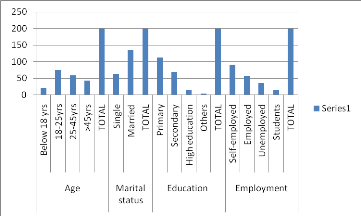
41
According to the variable age, most of respondents
are ranged between 18-25 years, representing 37, 5%. This meets the fact that
the above category represents the active population in general; while below 18
years of respondents have 11%, which means that this group have not yet begin
the income generating activities.
With regard to the marital status, the married group showed
68%, and became higher involved in savings and credit operations rather than
the single one. The explanation behind is that the single population is less
charged than the married group, in terms of people who are/are not dependents
on them. The person who has to satisfy the needs of many people has to increase
his incomes.
From the above table, results show that people with primary
level constitutes 56% of the respondents. Thus, 2.5% of respondents represents
category of others. The others group includes those who didn't finish their
primary school or never attended. We explain these findings as a result of the
microfinance's institutions deal with low income projects.
Reference made to employment status, the high number of
respondents (45.5%) is self-employed, whereas the students represent the small
group with 7,5%. These results match with the Rwandan government initiatives
which encourage people not to look at States employment, but to set up their
own business (entrepreneurship). In addition, students are few beneficiaries
because they launch their business simultaneously with their studies.
4.3. PRESENTATION OF RESULTS FROM QUESTIONNAIRES
Results from questionnaires are presented in different tables.
The questions have been formulated regarding the objectives and hypotheses of
the research. For each question, respondents had to choose their position
regarding the statement, and depending on the following
elements: strongly agree, agree, neutral, disagree and strongly
disagree.
Table 4: Women use savings and credit in economic activity for
their empowerment
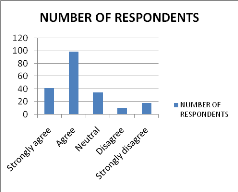
|
STATEMEN T
|
NUMBER OF RESPONDENT S
|
%
|
|
Strongly
|
41
|
20.50
|
|
agree
|
|
%
|
|
Agree
|
98
|
49%
|
|
Neutral
|
34
|
17%
|
|
Disagree
|
10
|
5%
|
|
Strongly
disagree
|
17
|
8.50%
|
|
Total
|
200
|
100%
|
42
Source: Primary data
From the tables above, most of respondents (49%) agreed with
the statement that women use saving and credit for economic activity, while a
small group of them (5%) were disagreed. It should also be noted that 20.5%
strongly agree with the statement. This means that 69.5% agree with the
statement at certain level. The neutral receives 17% of respondents. This may
result from low knowledge or lack of information on existence of schemes that
help women in promoting their economic activities.
Again 13.5% of the respondents do not agree with the
statement
Table 5: Women who benefit credit from Duterimbere IMF are
confined in range of female low-income activities
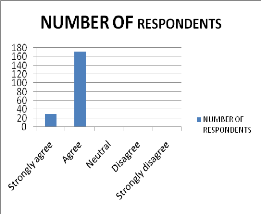
|
STATEMEN T
|
NUMBER OF RESPONDENT S
|
%
|
|
Strongly
|
29
|
14.50
|
|
agree
|
|
%
|
|
Agree
|
171
|
85.5
|
|
Neutral
|
0
|
0%
|
|
Disagree
|
0
|
0%
|
|
Strongly disagree
|
0
|
0%
|
|
Total
|
200
|
100%
|
43
Source: Primary data
According to the table above, 14.5% of respondents strongly
agree while 85.8% only agreed that economic contribution may increase women
role in economic decision-making in the household and leading to greater
well-being for women, children as well as men. Again none of the respondents
disagree with the statement. This shows the high level of knowledge by the
respondents on the criteria as of benefiting credits.
Table 6: Women economically-developed change gender role and
status within household and community
|
STATEMENT
|
NUMBER OF
RESPONDENTS
|
%
|
|
Strongly
|
45
|
22.5
|
|
agree
|
|
%
|
|
Agree
|
114
|
57%
|
|
Neutral
|
19
|
9.5%
|
|
Disagree
|
22
|
11%
|
|
Strongly disagree
|
0
|
0%
|
|
Total
|
200
|
100%
|
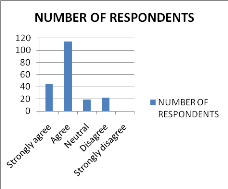
Source: Primary data A big number of respondents 57% confirms
that the women economically-developed change gender role and status within
household and community, 22.5%, 9.5% ,11% and 9.5% strongly agree, are neutral
and disagree respectively with the role of economic of women in household and
the communities while 0% of respondent strongly disagree with the statement.
Table 7: Microcredit given by Duterimbere IMF is limited
according to the beneficiary
|
STATEMEN T
|
NUMBER OF RESPONDENT S
|
%
|
|
Strongly
|
77
|
38.50
|
|
agree
|
|
%
|
|
Agree
|
123
|
61.50
|
|
|
%
|
|
Neutral
|
0
|
0%
|
|
Disagree
|
0
|
0%
|
|
Strongly disagree
|
0
|
1.50%
|
|
Total
|
200
|
100%
|
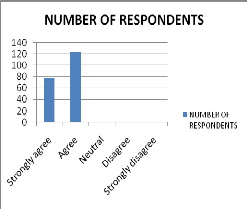
44
Source: Primary data From the table above, 61.5% of respondents
agree that the microcredit given by Duterimbere IMF is limited according to the
beneficiary and 77 persons (38.5%) strongly agree with the same statement.
Table 8: Microcredit provided by Duterimbere IMF is enough to
women empowerin
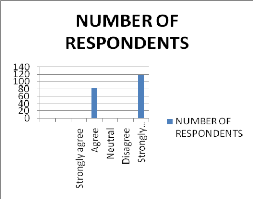
STATEMENT
|
NUMBER OF
RESPONDENTS
|
%
|
|
Strongly agree
|
0
|
0%
|
|
Agree
|
82
|
41%
|
|
Neutral
|
0
|
0%
|
|
Disagree
|
0
|
0%
|
|
Strongly disagree
|
118
|
59%
|
|
Total
|
200
|
100%
|
Source: Primary data
According to the table above, 41% of respondents agree that:
Microcredit provided by Duterimbere MFI is enough to women empowering while 59%
of respondents strongly disagree with the statement. This means that the
majority confirmed microcredit provided by Duterimbere is not enough in case of
the women empowerment.
Table 9: Women appreciate the short-term loan from Duterimbere
MFI for their
empowerment purpose

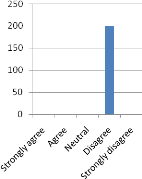
45
|
STATEMENT
|
NUMBER OF
RESPONDENTS
|
%
|
|
Strongly agree
|
0
|
0%
|
|
Agree
|
0
|
0%
|
|
Neutral
|
0
|
0%
|
|
Disagree
|
200
|
100%
|
|
Strongly disagree
|
0
|
0%
|
|
Total
|
200
|
100%
|
Source: Primary data
According to the above table, all respondents (100%) have been
disagreed the short-term loan from Duterimbere IMF for their empowerment. It
means that time allocated to the repayment of credit is not enough according to
the capacity of the initiated business.
Table 10: Women may be economically self-sufficiency due to
microcredit without the men support
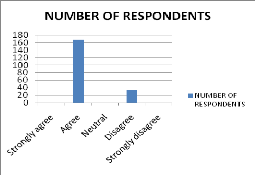
|
STATEMENT
|
NUMBER OF
RESPONDENTS
|
%
|
|
Strongly agree
|
0
|
0%
|
|
Agree
|
112
|
560%
|
|
Neutral
|
0
|
0%
|
|
Disagree
|
55
|
27.50%
|
|
Strongly disagree
|
33
|
16.50%
|
|
Total
|
200
|
100%
|
46
Source: Primary data
The above table shows that 112 respondents (56%) agreed that
most women may be economically self-sufficiency due to microcredit without the
men compared to 33 respondents (16.5%) who did not strongly agree with the
statement.
Table 11: Socio-demographics variables such as education
level, age, marital and professional status lead to success of microcredit in
women empowerment
|
STATEMEN T
|
NUMBER OF RESPONDEN TS
|
%
|
|
Strongly agree
|
13
|
6.50%
|
|
Agree
|
61
|
30.50
|
|
|
%
|
|
Neutral
|
27
|
13.50
|
|
|
%
|
|
Disagree
|
39
|
19.50
|
|
|
%
|
|
Strongly disagree
|
60
|
30%
|
|
Total
|
200
|
100%
|
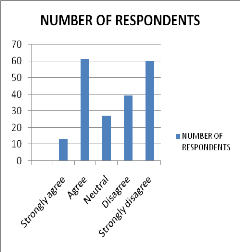
47
Source: Primary Data From the above data, 6.5% strongly agree
and 30.5% agree that Socio-demographics variables such as education level, age,
marital and professional status lead to success of microcredit in women
empowerment and/or what little income they earn may substitute for former male
household contributions as men retain more of their earnings for their own use.
13.5% of respondents are neutral while 19.5% and 30% strongly disagree and
disagree with the statement respectively
Table 12: Business held by women is competitive with others
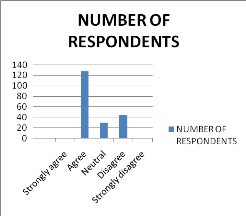
|
STATEMENT
|
NUMBER OF
RESPONDENTS
|
%
|
|
Strongly agree
|
0
|
0%
|
|
Agree
|
127
|
63.50%
|
|
Neutral
|
29
|
14.50%
|
|
Disagree
|
44
|
22%
|
|
Strongly disagree
|
0
|
0%
|
|
Total
|
200
|
100%
|
Source: Primary data
The table shows that 63.5% of respondents confirmed that Business
held by women is competitive with others and reproductive tasks, 44% disagreed
with the statement while 14.5% of respondents did not comment about the
subject.
Table 13: Microcredit offered to women improves the family
standing
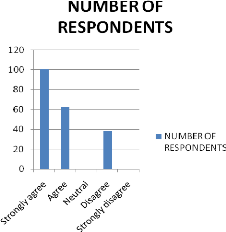
48
|
STATEMENT
|
NUMBER OF
RESPONDENTS
|
%
|
|
Strongly agree
|
100
|
50%
|
|
Agree
|
62
|
31%
|
|
Neutral
|
0
|
%
|
|
Disagree
|
38
|
19%
|
|
Strongly disagree
|
0
|
0%
|
|
Total
|
200
|
100%
|
Source: Primary data
From the above table, most of respondents (50%) were strongly
agreed, and 31% agreed that the microcredit offered to women improves the
family standing, whereas 38% of them disagreed with the statement.
Table 14: Women empowerment involves the family and community
development
|
STATEMENT
|
NUMBER OF
RESPONDENTS
|
%
|
|
Strongly agree
|
36
|
18%
|
|
Agree
|
164
|
82%
|
|
Neutral
|
0
|
0%
|
|
Disagree
|
0
|
0%
|
|
Strongly disagree
|
0
|
0%
|
|
Total
|
200
|
100%
|
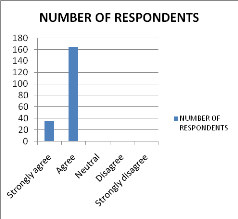
Source: Primary data 18% 0f the women interviewed strongly agreed
to Women empowerment involves the family and community development have highest
the important in the family promotion and the number of the 82% of respondents
agreed with the statement.
Table 15: Family economy may be based on the women empowerment
due to Savings and credit through microfinance
49
|
STATEMENT
|
NUMBER OF
RESPONDENTS
|
%
|
|
Strongly agree
|
161
|
80.50%
|
|
Agree
|
23
|
11.50%
|
|
Neutral
|
0
|
0%
|
|
Disagree
|
7
|
3.50%
|
|
Strongly disagree
|
9
|
4.50%
|
|
Total
|
200
|
100%
|
Source: Primary data
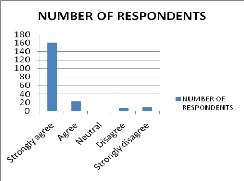
50
The study shows that 80.5% of the women respondents were
particularly proud of the financial contribution of the loan received to their
empowerment especially in their family and 11.5% of respondents agreed with the
same. However, 4.5% and 3.5% disagreed and strongly disagreed with the
statement respectively.
4.4. DISCUSSION OF RESULTS
The researcher expressed her interest to conduct microfinance
impact assessment among PTH through Duterimbere MFI women clients and their
path to economic development. It has been recognized that PTH through
Duterimbere MFI is doing an outstanding work to ensure transformation of lives
of Rwandan poor women who have been lagging behind economically due to
political, social and cultural barriers.
However, Rwandan academicians and the public alike do have
limited knowledge about intervention that PTH through Duterimbere MFI has been
providing to bring economic independent, pride, and confidence and build power
in decision making to the women clients.
4.4.1. DISCUSSION OF RESULTS FROM QUESTIONNAIRES
The results from our research have confirmed the contribution
of microfinance in women empowerment in Rwanda. Different questionnaires
answered by respondents have underlain the above assumption. Some of these
questions have evaluated the use of savings and credits in economical activity
for women empowerment, and this met the agreement of most of respondents.
Indeed, when the people resources are limited or no existent, they have to look
on low-income generating activities in order to gain money. In regards to the
socio-demographic variables, the majority of respondents are married,
self-employed, achieved only the primary level, and are aged between 18-25
years. This justifies the fact that respondents in the mentioned categories
deal with microfinance in terms of saving & credits for their survival. The
requirements to beneficiate the credit from the microfinance are flexible
rather than in other Banks. Currently in Rwanda, it has been evidenced that
none can get better economically without the credits and savings operations.
Further, another item has questioned about the change of
gender role and status within household & community by economically
developed-women. In the past, women in Rwanda were not considered with
appropriate dignity. Since they have been involved in business and other
responsibility, they have changed that mentality. From our research, most of
respondents have
51
agreed with the statement. Effectively, women empowerment
affects their status not only in their place of residence but also within the
community, and this constitutes the sum or the result of their status change.
The women economically-developed need their involvement in income generating
business, which imply the use of saving and credit operations.
On the other hand, the women appreciation towards the
microcredit provided by Duterimbere IMF in their empowerment has been analyzed,
and most of respondent have expressed their wish to increase the amount of
credit offered by Duterimbere. All the same, the research has evidenced that
most of clients who benefit from Duterimbere's microcredit have agreed to be in
female low-income activities. This means that women who deal with Duterimbere
IMF would like to have more amount of credit for high income generating
activities. Obviously, it emphasizes that a low income generating activity
becomes later a high income generating activity, and justifies the contribution
of microfinance in women empowerment.
Thus, respondents have agreed that through the microcredit,
women may become economically self-sufficiency even with the absence of men
support. This confirms the part of microfinance in women empowerment because in
former times, the woman has been for a long time financially dependent on man.
Currently, as long as Rwanda still obsessed by the women promotion in various
domains, their financial self-sufficiency will strengthen and make easy the
process. Besides, the Rwanda cabinet meeting held on 27th June,
2012, approved the strategies which intend to facilitate women and young people
to accede to credit within financial institutions for their economical
development.
Moreover, the research has interestingly enough evidenced that
most of participants were strongly agreed not only that the microcredit offered
to women in context of family impacts positively its standing improvement, but
also that the family economy may be based on the women empowerment due to
savings and credit through microfinance. One thing is for sure, woman has
always been the pillar of the family economical development. Furthermore, it is
known that the family development goes hand in hand with the community
development. Then, the women involvement in savings and credit process towards
microfinance leads up to the community promotion through the family one.
52
Based on the results of the present research, we intend to
emphasize on the strengthening of women empowerment through microfinance for
the following major achievements: firstly, as women constitute the high rations
among all Rwandan, they empowerment will become a key point in sustainable
development of the country. Secondly, the promotion of women through
microfinance enhances them to become more self-employed, and encourage gender
promotion which leads them to competitiveness with men. Thirdly, the
reinforcement of microfinance and the encouragement of people, women
especially, to deal with them contributes in poverty alleviation through
redaction of the rise in unemployment because people become job creator not job
seeker.
It is important to note that these results concern only PTH
through Duterimbere IMF and participants to the research. They can be
generalized neither to all microfinance institutions nor to all women who deal
with microfinance. Another limitation related to this research is linked to the
inaccessibility to all respondents for interview and observation of all their
projects. Thus, it has been difficult for us to evaluate with precision the
progression made by our respondents since it wasn't easy to eliminate all
factors which may have intervene in their economical development.
4.4.2. DISCUSSION OF RESULTS FROM INTERVIEW
We remind that some information have been obtained through
interview with a small group among Duterimbere IMF staff and its beneficiaries.
We mention that all information have been completed by observation on field for
some projects and consulting some Duterimbere IMF documents. The results from
interview have allowed us to draft the contribution or impact of Microfinance
in women empowerment, and the challenges experienced by both sides: institution
and beneficiaries (Women).
4.4.2.1. IMPACT OF MICROFINANCE IN WOMEN EMPOWERMENT
Since the most direct anticipated benefits of microfinance
concern are women clients' business, I shall begin with a discussion of the
effects of Microfinance program in that area. Running a successful business not
only contributes to women's improved welfare; it also contributes both directly
and indirectly to their economic empowerment. The interview held with the PFT
and Duterimbere IMF managing director showed that through microfinance
services, women's business become more successful in the following ways:
53
These services enable an increase in operating income that
affords women basic necessities, saving, self esteem, and self respect which
have improved relationships with families and communities, more strategic
planning and pricing, and diversification and expansion into more profitable
product lines.
Microfinance services ensure an increase in operating income
which is particularly important for women's economic empowerment through
generating their own capital or have access to cash credit and provides women
with considerable more power and prestige in the marketplace.
4.4.2.2. CHALLENGES EXPERIENCED BY DUTERIMBERE IMF IN
OFFERING
CREDIT
Women have limited knowledge for business transaction and
general business knowledge; this affects clients' business performance in term
of price negotiations and dealing with customers. Thus in turn affects income
returns which results into difficulties in their loan repayment. Product
diversification has been also a burden to Duterimbere IMF bank clients; where
by majority of the borrowers have diversified their loan into other activities
leading to loan repayment failure.
4.4.2.3. CHALLENGES EXPERIENCED BY BENEFICIARIES
(Women)
During the interview done with some women who have already
benefited microcredit from Duterimbere IMF, we have noted certain challenges.
The main challenges may be related to the educational background, where
beneficiaries who have completed only primary level are more than other
respondents (56%). This may easily arouse some doubt about the success of their
business. But, according to the talk of Mrs Chantal Mukarugomwa , we realized
that they struggle through somehow:» It was very difficult on the
started my business cause my little skills and also business experience, I have
not confident myself really I was lack the happiness and responsibility to take
some loan cause of the lack of capacity knowledge in the using of bank loan.
But according of the PTH through Duterimbere IMF advise I'm successful in
income generating business and I have high knowledge in using loan after the
different training given by PTH, RCA, MIGEPROF, Duterimbere IMF»;
Chantal said.
Another woman (Kampire Alice) respondent from Muhima Sector
said «my husband used to get angry whenever
I would kneel before him (kneeling is a sign of respect that women pay to their
husbands) to ask for money to buy clothes or any other domestic item but now I
no longer kneel
54
before him to ask money frequently. Similarly, I used to
disturb neighbors and relatives asking for various things including clothes,
salt, soap but now I buy them on my own and we are now happy with my husband in
the house»
Also a woman (Uwibambe Angelique) respondent from Gikondo
sector said «I can now take out my husband for a drink and can buy
meat that he would find ready on table than before when he could eat meat and
drink outside in the bar alone and bought beans for the house»
The above stories suggest that through microfinance provided
by Duterimbere MFI, clients especially women have been empowered economically
and this has impacted positively on their household relations with the
husbands. However, when we probed to whether these women had full autonomy over
their monies, most reported to have joint bank accounts with their husbands
which raises questions to whether women really have `full' control over the
loans and profits that accrue thereof.
In general, the challenges by women faced in microfinance
services and in their business those are:
? Few women clients still lack self confidence to try other
business opportunities;
? Limite educational background as it is big problem in the
improvement for women's business;
? Excess household responsibilities that inhibit their
business concentration
? The loan they receive is not enough to satisfy their
business needs;
? Lack of tangible assets or properties to be used for larger
loan guarantee or caution in the case an individual women encounters loan
repayment problem has been one of the challenges
Few of the interviewee, pointed out that family
responsibilities take a lot of of women's time that could be applied for
improving their income generating efforts. Their responsibilty for children
care limits their mobility and obliges them to generate income in less
conducive environment for business.
55
CHAPTER FIVE: CONCLUSION AND RECOMMANDATIONS
5.1. INTRODUCTION
This chapter represents a brief summary of findings of the
study by expressing the general view of what the researcher discovered during
the research. It is also in this chapter that the researcher's recommendations,
suggestions and conclusion are mentioned.
5.2. CONCLUSION
The aim of this research is to explore the impact to
microfinance intervention on women economic empowerment and the circumstances
under which microfinance can help the poor women out of their poverty
situation. Microfinance provides employment to the poor women who have no other
means of income. Women are highly represented in self-employment and operating
small income generating activities. Therefore, microfinance has the potential
to have a powerful impact on women's economic empowerment.
Women need, want, and profit from credit and other financial
services. Strengthening women's financial base and economic contribution to
their families and communities plays a role in empowering them. To a large
extent, access to capital or credit may be the only input needed to start women
on the road to economic empowerment.
However, women have indicated that often they also value the
non economic benefits of microfinance services. Some of the most valued
benefits include expanded business and social networks, improved self esteem,
increased household decision making power, and increased respect and prestige
from both male and female relatives and community members.
Pro-Femmes/ Twese Hamwe through Duterimbere MFI has proved to
be a powerful instrument toward women empowerment, enabling them to build
assets, increase incomes, and reduce the vulnerability to economic stress. All
women who receive a loan, gain access to additional resources and have
succeeded in controlling their loans and using them to generate independent
incomes.
Targeting women continues to be important for Pro-Femmes/
Twese Hamwe through Duterimbere in design of its products and services, mainly
because women by default have less access to credit and because they face
constraints unique to their gender. Product design and program planning should
take women's needs and assets into account.
56
By building an awareness of the potential impacts of their
programs, PTH through Duterimbere can design product, services, and service
delivery mechanisms that can break women economic dependence and enhance their
economic empowerment.
Even when products and services target primarily women, some
women still face considerable challenges relative to men because of more
limited resources (land, houses) greater domestic burden, weaker self
confidence and less education.
Some do target the most vulnerable, while others target the
entrepreneurial poor and the not-so-poor. Furthermore, the clients interviewed
may have started off very poor and improved their livelihood through the
microfinance, made available by Profemmes Twese Hamwe partners. Obviously, even
if a client is not «ultra-poor», she may have a long way to go before
attaining a sustainable livelihood. Microfinance makes a valuable contribution
to reaching that goal.
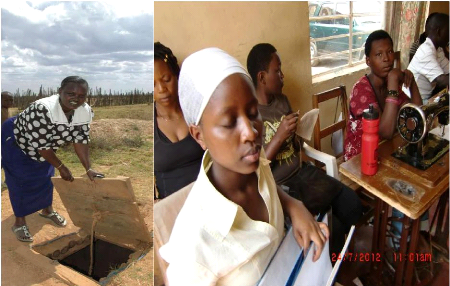
In just a few years period Mukamisha Leoncie has gone from
dependence on food aid to producing and distributing food products and
employing members of the community thanks to loans of Duterimbere Microfinance
as well as the widow women association.
Awareness Based on the reasons given by PTH
offices and MFI partners for the cause of women not being able to enter into
certain businesses, there is ample scope for gender-related awareness rising.
Time required for caring tasks, lack of education and training, and inadequate
skills are
57
mentioned as reasons women cannot perform certain work. Land
ownership and sole capital ownership by men are apparently also still widely
available and acceptable reasons for withholding opportunities from women.
All in all, most interviewees seem satisfied with the
microfinance services as offered.
Most clients, in general, have a better life than before. By
implementing a limited number of changes to the microcredit programs of MFI
partner more direct involvement of PTH offices in gender related issues and
gender training at various levels optimal use can be made of knowledge already
available and enthusiasm at all levels. As Pro-Femmes/ Twese Hamwe is working
on a country wide scale, an extra increase in women's empowerment could benefit
women in many different countries.
In the Pro-Femmes/ Twese Hamwe offices that completed the
questionnaire, 54% of staff is female. The number of women staff is just one of
many criteria in a gender audit, but this is a positive result. There is a
relation between the number of women on staff and gender mainstreaming in
general. It is mainly through female staff that gender issues are really
mainstreamed, notwithstanding the fact that men have a positive view and input.
With regard to the expansion of gender and empowerment-related programming in
future, this is very promising.
Microfinance, one of Duterimbere in partnership with
Pro-Femmes/ Twese Hamwe main activities, can be a very useful instrument in
contributing to women's empowerment, and offers women a free choice with regard
to the way they want to use their talents. If some extra efforts are made, the
contribution could be even larger.
Microfinance has not been able to reach the poorest at the
bottom of the poverty line and therefore the claims that it will reduce poverty
for the majority poor remains a mere myth.
However, it's worth noting that, Pro-Femmes/ Twese Hamwe
through Duterimbere MFI has reached a number of poor people who previously had
been excluded from the formal banks. The program has been successful in
reaching the poor especially women who have not been served by the traditional
financial institutions and findings indicate that it has reduced poverty among
the borrowers.
The MFI also besides group-based lending program has recently
introduced individual lending for long term borrowers with excellent repayment
records. This will enable microfinance borrowers to easily graduate to formal
banking system in future. However, the study findings
58
indicate that microfinance was likely to have greater positive
impacts in urban than in the rural and this suggests differences in
opportunities, women poverty levels and microfinance products
appropriateness.
5.2. Recommendations/Suggestions
From the study, the following suggestions are devised to make
microfinance more effective as a tool for poverty reduction.
1. MFIs should have broader target group including the ones
in the extreme poverty. Moreover, according to Rwanda Microfinance Policy,
microfinance services should be available to all sections of the community,
particularly to the poorest and most vulnerable members of society. (Rep. of
Rwanda 2006);
2. The design of products and services should also be made
flexible to reflect the needs of the poor. As was found out by this study,
microfinance is most directed to income generating activities, or delivered to
those who have existing businesses, street trade or physical collateral.
3. This excludes a large majority of the poor people who
would need the products and services and cannot afford this collateral. It's
thus important to mention that there is need to improve the design and outreach
and to see MFI as part of the package for targeting the poor.
4. The credit delivery mechanism (group lending with a weekly
repayment schedule) can be effective in reaching a large number of small
producers but cannot reduce poverty on large scale. The poor engaged in
agriculture for instance would need a loan that would be paid when their
harvests are ready. This suggests that microfinance products and services
should be best tailored to the diverse needs of the poor people and the poor
should not be looked at as a homogeneous group of people. Products should as
well be contextualized taking into account rural-urban differences
5. To sum it up, microfinance is not a `magic» bullet
for poverty reduction and the increasing government's and aid agencies'
emphasis on microfinance as a panacea to poverty may be an over simplification
of the matter.
6.
59
The study findings indicate that MFI alone cannot meet the
needs and resolve a wide range of difficulties of the all poor women. There is
need for infrastructure developments for remote areas and need to improve
market potentials.
7. We suggest of starting with the development of a strategy
for encouraging women's empowerment. This should take place in conjunction with
all microfinance's actors to discuss how to support empowerment and how to
implement the strategic plan. I recommend pursuing a double bottom-line
strategy using a socially oriented approach to foster empowerment, while at the
same time stimulating financial sustainability and additionally, provisions for
monitoring must be made and MFIs should be involved and eventually assisted in
developing empowerment indicators.
8. Incentive systems should be set up on all levels to
encourage MFIs and Pro-Femmes/ Twese Hamwe to incorporate strategies and
activities supporting women's empowerment into their work. The key here is not
to provide more funds in general, but rather to specifically reward promising
and/or effective approaches.
9. Pro-Femmes/ Twese Hamwe needs to assist MFIs in adapting
their financial products and loan modalities to clients' needs. This process
includes obtaining information on which needs different client groups have
either through research or feedback from loan officers and clients themselves
and subsequently adapting the loan modalities. This can be done with the
participation of clients.
10. MFIs should adapt existing training programs and set up
new ones in response to clients' needs. With respect to introductory training,
as previously mentioned, transparency and full understanding of loan modalities
must be ensured. The current practice of one-day workshops will not be enough.
I also encourage provision of financial literacy training and strategic
transformative training, where women are not only confronted with calculation
and business skills, but also reflect on their current situation.
11. An internal communication and decision-making structure
between Pro-Femmes/ Twese Hamwe actors at all levels should be put in place.
These structures should be participatory and provide ample space for all
actors, especially the MFIs and the Technical service Provider, to include
their ideas and practical experiences and discuss what assistance they need to
successfully support women's empowerment. In additionally, information sharing
and knowledge management with and between MFIs
60
should be institutionalized. This is especially important at
the beginning of the new program phase where new priorities are set.
12. Despite increasing competition between MFIs to disburse
loans, both Pro-Femmes/ Twese Hamwe and its member MFIs must ensure that loans
are given responsibly to clients who can afford them. Pro-Femmes/ Twese Hamwe
should also encourage MFIs to re-evaluate their effective interest rates,
requests for collateral and policies on group guarantees as well as punitive
and legal measures in case of non-payment (e.g., criminalization of clients).
Such measures will guarantee responsible finance and ensure that the current
largely negative image of microcredit is counter balanced.
REFERENCES
1. Cheston, susy Kuhn, Lisa (2002). Empowering women
through microfinance; in Daley-Harris, Sam (ed) «Pathways out of provety:
Innovation in microfinance for the poorest families», Jumarian Press,
Bloomfiled Connecticut
2. Batliwala, Srilatha (1994). The meaning of women's
empowerment: new concepts from action, In G. Sen, A. Germain, and L.C.
Chen, (ed).Population politics reconsidered: Health, Empowerment and
Rights. Boston: Harvard University press.
3. Majanja (2002). Women enterprise development: (gains
and challenges) paper presented at women international conference, Kampala
Uganda 2002
4. Mayoux, Linda (2001). Tackling the Down Side: Social
Capital, Women's Empowerment and Micro-Finance in Cameroon, Development and
Change, Vol. 32, 2001 (1), 421-450.
5. Gulli, H. and M, Berger (1999). Microfinance and
Poverty Reduction-Evidence from Latin America, Small Enterprise
Development Vol. 10 No 3, Inter-American Development Bank
6. Ministry of Gender and Family Promotion, (2010).
National Gender Policy
7. HelgeRoxi, Heidi Berkmüller, Phillip John Koller,
Jennifer Lawonn, Nahide Pooya, Julia Schappert (2010). Economic Empowerment
of Women through Microcredit in Sierra Leone. Berlin 2010
8. Bigsten, A. and A, Isaksson (2008). Country Economic
Report; Growth and Poverty in Rwanda: Evaluating the EDPRS 2008-2012,
Sida, Department for Policy and Methodology
9.
61
Enterprising Solutions Global Consulting, LLC (2005). Rwanda
Micro Finance Assessment, Kigali
10. Fisher, T. and M.S.Sriram (2002). Beyond Micro-credit:
Putting development back into microfinance, Vistaar Publications, New
Delhi
11. Guerin, I & J, Palier (2005). Micro-Finance
Challenges: Empowerment or Disempowerment of the poor? French Institute of
Pondicherry, India
12. Iribagiza, D (2007). A report on Industrial Training
carried out in Urwego Opportunity microfinance Banking S.A, School of
Finance and Banking, Kigali Rwanda
13. Kabeer, N. (2000). Conflicts over credit: Re-Evaluating
the Empowerment Potential of Loans to Women in Rural Bangladesh, World
Development Vol.29, No.1, pp 63-84, 2001, GreatBritain
14. Kereta, Befekadu, B. (2007). Outreach and financial
Performance: Analysis of Microfinance Institutions in Ethiopia, African
Economic Conference Centre (UNCC), AddisAbaba, Ethiopia
15. Khandker, Shahindu, R. (1998). Fighting Poverty with
Microcredit: Experience in Bangladesh,Oxford University Press, New York
16. Mayoux, L. (2001). Tackling the Downside: Social
Capital, Women's Empowerment and Microfinance in Cameroon, Development and
Change, Vol.32, No.3 pp.435-464
17. Momoh, J. (2005). The Role of Micro-financing in Rural
Poverty Reduction in Developing Countries, Wismar Discussion Papers,
University of Technology, Business and Design, Wismar, Germany
18. Ahmed Obaid, Thoraya,( 2002). Empowering women through
microcredit: progress and possibilities. Statement by the executive
director, UNFPA. United Nations Headquarters, New York.
Internet Sources
1. Deshmukh- Ranadive,J. 2008, Can microfinance empower women?
Indian school of microfinance for women. At URL:
http://www.ismw.org.in/highlights1.asp
(viewed 25/08/2009)
2. Development projects to promote economic empowerment of
women:
www.munfw.org/archive/50th/undp1.htm
(viewed 30/08/2009)
3.
62
Role of microfinance in empowering women in Africa. At URL:
http://www.africanexecutive.com/modules/magazine/articles.php/article
4.
http://www.betterworld.net/quotes/microcredit-quotes
accessed on 08th Nov.2008
5.
http://www.bnr.rw accessed on 04 June
2008
6.
http://www.countercurrents.org
accessed on 22nd Oct 2008
7.
http://www. Mixmarket.org
accessed on 30th Oct 2008
8.
http://www.opportunity.org
accessed on 4th Sept 2008
APPENDICES
1. Questionnaire
2. Interview guide

RESEARCH QUESTIONNAIRE Dear Respondent,
I'm pursuing the program of Master of Commerce at Lovely
Professional University (LPU). And I'm doing a survey on the
CONTRIBUTION OF MICRO-FINANCE IN WOMEN EMPOWERMENT. That is
why I inviting all of you to take part in this survey, please answer the
following questions as much as you can.
Thank you for your support.
Procedure of Survey: This
questionnaire contains 12 questions at which every participant must answer each
and every question.
Quote of Survey:
1. The quoted in this survey are both sex, male and female of
age between 18 to above 45 years.
2. Marital status: (1) Single (2) Married, (3) Widow
3. Level of education from Senior School (Secondary School)
up to the above Post graduate level.
4. The employment status
I. Regarding Survey
1. Full Name of respondent:
2. Gender : ( Tick the appropriate)
(1) Male
(2) Female
1. Full Name of respondent
2. Gender : ( Tick the appropriate)
(1) Male (2) Female
3. Which of the following ranges includes your ages? ( Tick the
appropriate)
(1) Below 18 (2) 18 to 25 (3) 25to 45 (4) Above 45
4. II
Highest level of education you have completed ( Tick the
appropriate)
(1) Primary school (2) Secondary (3) High education (4)
Others
5. Marital status ( Tick the appropriate)
(1)Single (2) Married, (3) Widow
6. What is your employment status? ( Tick the appropriate)
(1)Self-employed (2) Employed (3) Unemployed (4) Student (5)
Others II. Questions (Tick the appropriate quadrant)
|
No
|
Statements
|
Strongly disagree
|
Disagree
|
Neutral
|
Agree
|
Strongly agree
|
|
1
|
Women use savings and credit in
economic activity for their
empowerment
|
1
|
2
|
3
|
4
|
5
|
|
2
|
Women who benefit credit from Duterimbere IMF are confined in
range of female low-income
activities
|
1
|
2
|
3
|
4
|
5
|
|
3
|
Women economically-developed
change gender role and status
within household and
community
|
1
|
2
|
3
|
4
|
5
|
|
4
|
Microcredit given by Duterimbere IMF is limited according to the
beneficiary
|
1
|
2
|
3
|
4
|
5
|
|
5
|
Microcredit provided by
Duterimbere IMF is enough to women empowering
|
1
|
2
|
3
|
4
|
5
|
III
|
|
|
|
|
|
|
|
6
|
Women appreciate the short-term loan from Duterimbere IMF for
their empowerment purpose
|
1
|
2
|
3
|
4
|
5
|
|
7
|
Women may be economically self-
sufficiency due to microcredit
without the men support
|
1
|
2
|
3
|
4
|
5
|
|
8
|
Socio-demographics variables such
as education level, age,
marital and
professional status lead to success
of microcredit in women
empowerment
|
1
|
2
|
3
|
4
|
5
|
|
9
|
Business held by women are
competitive with others
|
1
|
2
|
3
|
4
|
5
|
|
10
|
Microcredit offered to women
improves the family standing
|
1
|
2
|
3
|
4
|
5
|
|
11
|
Women empowerment involves
the family and community
development
|
1
|
2
|
3
|
4
|
5
|
|
12
|
Family economy may be based on the women empowerment due to
savings and credit through
microfinance
|
1
|
2
|
3
|
4
|
5
|
Adeline Mukayiranga
LPU/Faculty of Economics and Commerce /Department of Finance
(Punjab- India) Cell phone: 0788531085/
Email:
adelinekayiranga@yahoo.fr
INTERVIEW QUESTIONS
1. Briefly describe your services
2. Who are your customers? Among them, many of those are
women?
3. In percentage wise, how many women applied for microcredit
loans in the year2011?
4. What would you think are the challenges facing microfinance
in dealing with women Clients?
5. How does the participation of women in microfinance helps to
improve their quality of life?
6. What are the criteria used to enable women qualified for
microfinance loans?
7. Does participation of women in microfinance reduce their
economic vulnerability? If yes how?
8. In which way has microfinance led to economic empowerment of
women?
9. After using the loan acquired from Duterimbere MFI, have you
income increased?
10. After acquiring the loan from Duterimbere MFI and carrying
out your personal activities, have your management skills increased?
11. What are the problems in improvement for women empowerment
in Rwanda? Thank you so much for your participation
iv
Adeline Mukayiranga
| 

